- Link to facebook
- Link to linkedin
- Link to twitter
- Link to youtube
- Writing Tips

The Appendix (How to Use One in an Essay)
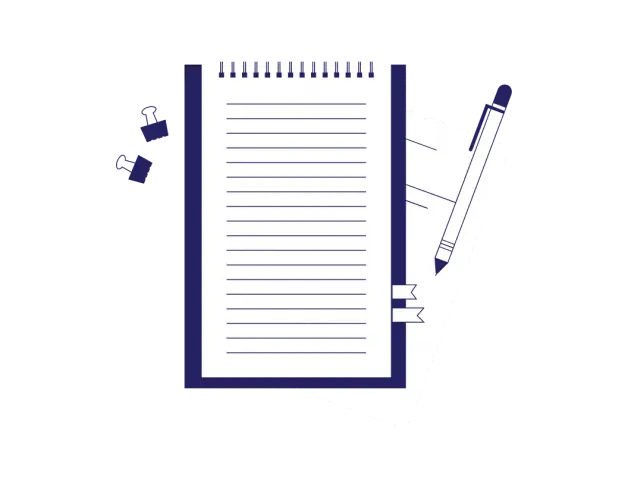
2-minute read
- 30th March 2017
The appendices in an essay are not typically essential, but they can play an important supporting role. Not everyone knows how to use an appendix in academic writing , though, so we’ve prepared this handy guide.
What Is an Appendix?
An appendix (plural: appendices ) is a section at the end of a book or essay containing details that aren’t essential to your work, but which could provide useful context or background material.
In the main body of your essay, you should indicate when you’re referring to an appendix by citing it in parentheses. For example:
The interviews show that most people like ice cream (see Appendix C).
What Should Go in the Appendices?
Appendices can include many things depending on your topic. Common examples of information added to an appendix include:
Find this useful?
Subscribe to our newsletter and get writing tips from our editors straight to your inbox.
- Raw data from tests
- Technical figures, graphs or tables
- Maps, charts or images
- Letters or emails used in research
- Sample questionnaires or surveys
- Full interview transcripts
What these have in common is that you might need to refer to them in an essay without going into too much detail. For example, you might summarise the results of a test in the ‘Results’ section of a dissertation, then include the full data in appendices to ensure clarity.
How to Format Appendices
Exactly how to format appendices can vary between universities, so you should always check your style guide. Generally, though, appendices should:
- Appear at the end of your document, often after the reference list
- Be divided into sections depending on topic (e.g. separate sections for questionnaire results and interview transcripts)
- Have each appendix section start on a new page
- Be labelled with a letter or number, along with a title clarifying content (Appendix A: Instrument Diagrams, Appendix B: Test Results, etc.)
- Appear in the table of contents at the beginning of your document

Are Appendices Included in the Word Count?
Appendices are not usually included in the word count for an essay. Consequently, you can focus on key information in your work and place extra data in an appendix without worrying about the word count.
However, you should always check your style guide on this. And remember that if you rely on something in your main essay, it needs to be included there: you can’t just shuffle it into the appendices to reduce the word count !
Share this article:
Post A New Comment
Get help from a language expert. Try our proofreading services for free.
9-minute read
How to Use Infographics to Boost Your Presentation
Is your content getting noticed? Capturing and maintaining an audience’s attention is a challenge when...
8-minute read
Why Interactive PDFs Are Better for Engagement
Are you looking to enhance engagement and captivate your audience through your professional documents? Interactive...
7-minute read
Seven Key Strategies for Voice Search Optimization
Voice search optimization is rapidly shaping the digital landscape, requiring content professionals to adapt their...
How to Ace Slack Messaging for Contractors and Freelancers
Effective professional communication is an important skill for contractors and freelancers navigating remote work environments....
3-minute read
How to Insert a Text Box in a Google Doc
Google Docs is a powerful collaborative tool, and mastering its features can significantly enhance your...
How to Cite the CDC in APA
If you’re writing about health issues, you might need to reference the Centers for Disease...

Make sure your writing is the best it can be with our expert English proofreading and editing.

Easy Guide on How to Write an Appendix

Understanding What Is an Appendix
Many students ask, 'What is an appendix in writing?'. Essentially, an appendix is a compilation of the references cited in an academic paper, prevalent in academic journals, which can be found in any academic publication, including books. Professors frequently require their students to include an appendix in their work.
Incorporating an appendix in your written piece can aid readers in comprehending the information presented. It is important to note that different professors may have varying guidelines on how to write an appendix. To learn more about how to write an appendix for a research paper according to APA, Chicago, and MLA styles, check out the following paragraphs prepared by our PRO nursing essay writing service !
Meanwhile, note that an appendix comprises all the information utilized in a paper, including references and statistics from several authors and sources (the number varies according to the type of academic paper). The purpose of the appendix is to prevent vague or irrelevant information and improve the reader's understanding of the paper.
The Purpose of an Appendix
To understand what an appendix tries to accomplish and how to write an appendix example, after all, we must first answer the key question, 'What is the purpose of an appendix?'. In short, an appendix is crucial for further explaining complex information that may be difficult to fully convey within the main text of an essay. It is intended to offer readers additional information about the topic addressed in the paper.
The material presented in an appendix has the potential to bolster the argument and sway the reader's opinion. Nonetheless, you should try to incorporate supporting material and examples toward the end of the paper to avoid disrupting the flow of the main text. Furthermore, the likelihood of including an appendix increases as a paper becomes more advanced. The use of an appendix is especially prevalent in the academic writing of a research document and journal-style scientific paper, in which extra information is usually needed to support a main point of view.
How to Structure an Appendix
While there are variations between formats, each one follows a basic structure. Thus, understanding the general structure is an essential first step in learning about this topic. No matter if you're tasked with 'how to write an appendix MLA or APA style?' - remember that both adhere to this structure, despite their differences:

Order an Essay Now & Get These Features For Free :
Every Appendix Should Contain:
- A clear title: The title of the appendix should be concise and descriptive, clearly indicating what information is contained within it. For example, 'Appendix A: Data Tables for Study Results or 'Appendix B: Images of Experimental Setup.'
- A list of contents: Including a table of contents in the appendix can be helpful for readers to navigate the information provided. For example:
Table of Contents:
A. Data Tables for Study Results
B. Images of Experimental Setup
C. Survey Questions and Responses
D. Sample Interview Transcripts
- Page numbers: The appendix should be a separate page, independently numbered from the main body of the paper, and specified uniformly (e.g., 'Appendix A,' 'Appendix B,' etc.). For example:
Page 1 of 5
- Relevant information: The appendix should contain all the relevant information supporting the main arguments of the document, including tables of data, raw statistical data, charts, or other documents. For example:
Figure 1: Experimental Results
[insert graph or chart here]
- Proper formatting: The appendix should be formatted in accordance with the specific requirements of the chosen citation style (e.g., APA, MLA, Chicago). For example:
Appendix B: Survey Questions and Responses
[insert survey questions and responses here, formatted following APA style guidelines]
- Clear labeling: Each element should have a clear appendix label so readers can easily understand its relevance to the paper. For example:
Table 1: Demographic Characteristics of Survey Respondents
- Concise explanation: It is important to provide short detailed descriptions of each element in the Appendix so that readers can understand its importance. For example:
Appendix C: Sample Interview Transcripts
Transcripts of the three interviews with the study participants shall be included for reference. These interviews provide further insights into the experiences of participants and their views on the subject addressed in this document.
Need college essay help ? You can always ask us to do a custom term paper from our professional writers.
General Appendix Format
To ensure proper formatting, it is important to understand the basics of how to structure an appendix. Although it may seem overwhelming, the basic format is relatively easy to comprehend and serves as a foundation for understanding the APA and MLA formats. Additionally, mastering the basic format can be helpful when writing an appendix for a book or dissertation.

- Heading “Appendix #” . Contains a number or letter, that could be 1 or A.
- Reference List.
- Index Table followed a list of appendices.
- Page Number.
Do You Need More Help With Your APPENDIX?
Get help from professional writers asap!
How to Write an Appendix in Different Styles
There are two distinct styles for creating an appendix, and it's important to familiarize yourself with both since a professor may request one or the other. Our expert writers have compiled guidelines and rules for both formats - the Appendix APA format and the Appendix MLA format. Although they share some similarities, they also have unique features and regulations that must be strictly followed.
Appendix APA
Many professors require students to write an appendix in a paper of this format. To master how to write an appendix APA format and get the structure correct, it's a good idea to follow these guidelines and rules:
The guidelines for Appendix APA:
- The appendix begins with the heading 'Appendix' followed by ABC.
- It should also be written on top of the appendix title.
- Every appendix follows the order of the stated information in the paper.
- Include the appendix after the reference list.
- Include page numbers for each appendix.
- Appendices are to have their own page, regardless of the size.
- Include Footnotes.
The general rules for Appendix APA are to be followed when writing. This is what professors look for when a paper is required when apprentices are to be written in this format. Learn the general rules to master how to write an appendix APA style and get you onto the right path to success. You may find it useful to memorize this information or keep a note of it.
Rules for APA:
- All appendices should include their own point.
- Include a title for each appendix.
- For multiple appendices, use ABC for tilting them.
- For reference within the body, include (see appendix a) after the text.
- The title should be centered.
- All appendices are to have their own page, regardless of the size.
- Paragraph One should be written without indents.
- The rest of the paragraphs should have the intended formatting.
- Include double spacing.
Whether you're tackling how to write an interview paper in APA appendix or any other type of academic work, the following example can serve as a valuable blueprint to guide you through the process.
Appendix Chicago Style
Writing an appendix Chicago style is rather similar to APA. Though, there are some minor differences. Take a look at these guidelines for this form of an appendix.
Guidelines for an Appendix Chicago Style
- More than one appendix is described as appendices.
- The font required for the appendix Chicago style is Times New Roman.
- The text size should be 12 points.
- The page numbers should be displayed on the top right of each page.
- The page numbers should also be labeled as 'Page 1,2,3'.
- Avoid including a page number on the front cover.
- The bibliography should be the final new page. It should not share a page with any other content.
- It is possible to include footnotes in the bibliography.
To better comprehend how to write an appendix in Chicago style, glance through the example below:
Appendix MLA Format
The guidelines and regulations for creating an appendix in MLA format are largely similar to those in APA format. However, there are some differences between the two, the most notable being that the MLA appendix is placed before the reference list.
The guidelines for MLA Format:
- The appendix is included before the list of references.
It may be useful to follow the example of an appendix to better understand how to write an appendix in MLA style. Doing so can increase the chances of getting a grasp of the MLA rules to fulfill the requirements of your professor on your academic paper.
Rules for MLA
- The title is to be centered.
- The list should be double-spaced.
- The first line should include each reference in the left margin. Every subsequent line is to be formatted so it's invented. This can be referred to as 'hanging indent' to make things easier.
- The reference list must be in alphabetical order. This can be done with the first letter of the title of the reference. Though, this is usually done if the writer is unknown. If the writer is known, you can also use the first letter of the surname.
- If you include the name of the known writer, use this order. SURNAME, FIRST NAME, YEAR.
- Italic fonts are required for the titles of complete writings, internet sites, books, and recordings.
- It is important not to use an italic font on reference titles that only refer to the part of a source. This includes poetry, short papers, tabloids, sections of a PDF, and scholarly entries.
Before we conclude, let's dive deeper into the world of appendix writing by exploring an example of how to write an appendix MLA style.
Let's wrap this up! It's safe to say that following the APA, Chicago, and MLA formats is crucial when crafting an appendix. As we've seen, starting with an APA appendix example can help ease you in mastering how to write an appendix of paper. Once you have a handle on the precise formats and guidelines, creating an appendix becomes a piece of cake. Also, memorizing the format can help you whip up accurate appendices for any type of paper, whether an essay or a dissertation. Trust us, mastering this topic is a must if you want to excel in knowing how to write an appendix in a report or any other academic work.
Moreover, if you ever find yourself in need of additional academic assistance, be sure to check out our resources on how to write an article review . Or, better yet, why not let us handle your most challenging tasks with ease by simply sending us a ' write my paper request? We are here to support you every step of the way.
Get Immediate Writing Help
Our appendix pages are written with the customer’s needs in mind, and plagiarism-free. Why not give it a try?
What Is An Appendix In Writing?
What is the purpose of an appendix, how to format an appendix.

Daniel Parker
is a seasoned educational writer focusing on scholarship guidance, research papers, and various forms of academic essays including reflective and narrative essays. His expertise also extends to detailed case studies. A scholar with a background in English Literature and Education, Daniel’s work on EssayPro blog aims to support students in achieving academic excellence and securing scholarships. His hobbies include reading classic literature and participating in academic forums.

is an expert in nursing and healthcare, with a strong background in history, law, and literature. Holding advanced degrees in nursing and public health, his analytical approach and comprehensive knowledge help students navigate complex topics. On EssayPro blog, Adam provides insightful articles on everything from historical analysis to the intricacies of healthcare policies. In his downtime, he enjoys historical documentaries and volunteering at local clinics.
.webp)
Have a language expert improve your writing
Run a free plagiarism check in 10 minutes, generate accurate citations for free.
- Knowledge Base
- Research paper
- Research Paper Appendix | Example & Templates
Research Paper Appendix | Example & Templates
Published on August 4, 2022 by Tegan George and Kirsten Dingemanse. Revised on July 18, 2023.
An appendix is a supplementary document that facilitates your reader’s understanding of your research but is not essential to your core argument. Appendices are a useful tool for providing additional information or clarification in a research paper , dissertation , or thesis without making your final product too long.
Appendices help you provide more background information and nuance about your thesis or dissertation topic without disrupting your text with too many tables and figures or other distracting elements.
We’ve prepared some examples and templates for you, for inclusions such as research protocols, survey questions, and interview transcripts. All are worthy additions to an appendix. You can download these in the format of your choice below.
Download Word doc Download Google doc
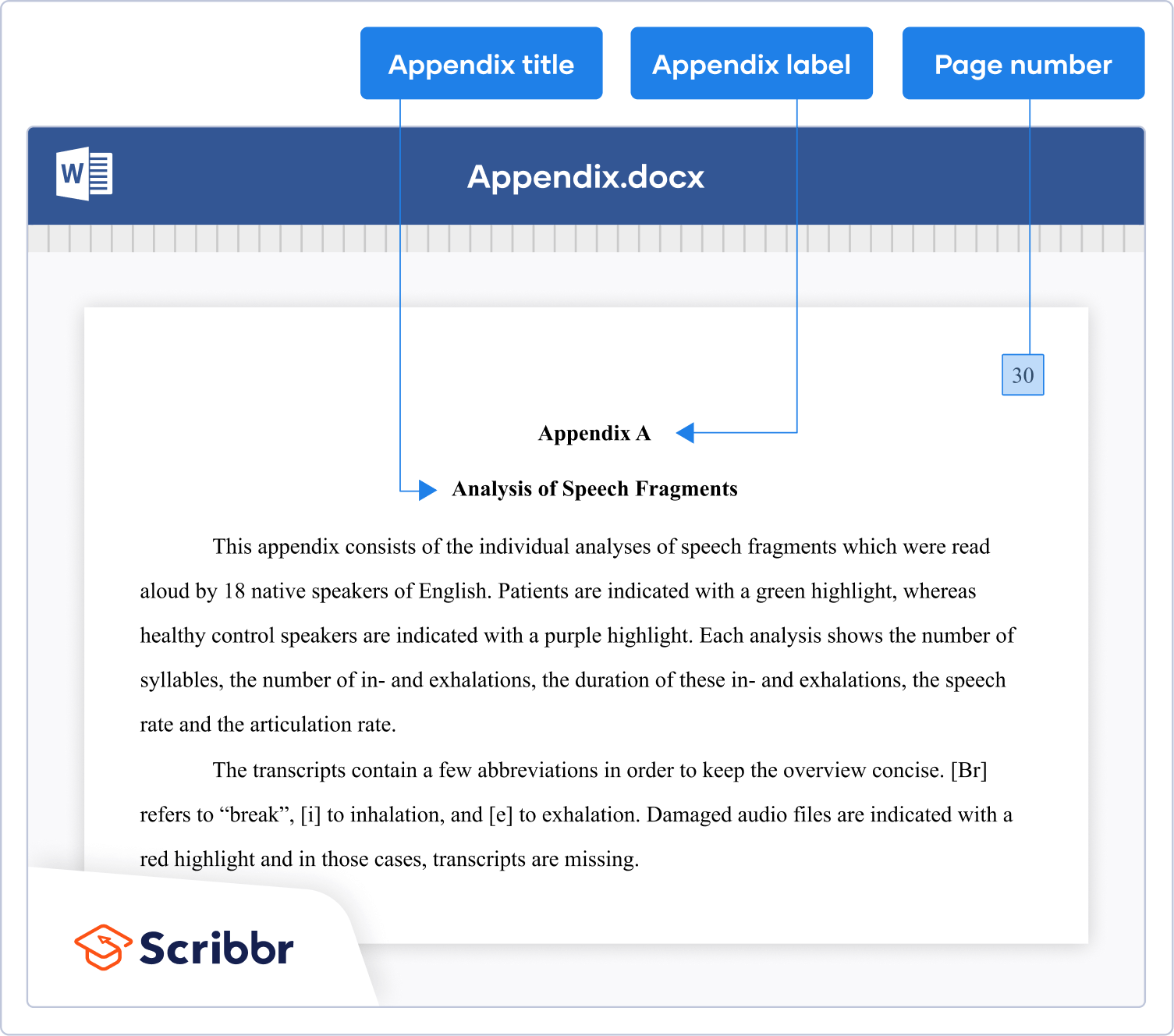
Instantly correct all language mistakes in your text
Upload your document to correct all your mistakes in minutes

Table of contents
What is an appendix in a research paper, what to include in an appendix, how to format an appendix, how to refer to an appendix, where to put your appendices, other components to consider, appendix checklist, other interesting articles, frequently asked questions about appendices.
In the main body of your research paper, it’s important to provide clear and concise information that supports your argument and conclusions . However, after doing all that research, you’ll often find that you have a lot of other interesting information that you want to share with your reader.
While including it all in the body would make your paper too long and unwieldy, this is exactly what an appendix is for.
As a rule of thumb, any detailed information that is not immediately needed to make your point can go in an appendix. This helps to keep your main text focused but still allows you to include the information you want to include somewhere in your paper.
Don't submit your assignments before you do this
The academic proofreading tool has been trained on 1000s of academic texts. Making it the most accurate and reliable proofreading tool for students. Free citation check included.

Try for free
An appendix can be used for different types of information, such as:
- Supplementary results : Research findings are often presented in different ways, but they don’t all need to go in your paper. The results most relevant to your research question should always appear in the main text, while less significant results (such as detailed descriptions of your sample or supplemental analyses that do not help answer your main question), can be put in an appendix.
- Statistical analyses : If you conducted statistical tests using software like Stata or R, you may also want to include the outputs of your analysis in an appendix.
- Further information on surveys or interviews : Written materials or transcripts related to things such as surveys and interviews can also be placed in an appendix.
You can opt to have one long appendix, but separating components (like interview transcripts, supplementary results, or surveys ) into different appendices makes the information simpler to navigate.
Here are a few tips to keep in mind:
- Always start each appendix on a new page.
- Assign it both a number (or letter) and a clear title, such as “Appendix A. Interview transcripts.” This makes it easier for your reader to find the appendix, as well as for you to refer back to it in your main text.
- Number and title the individual elements within each appendix (e.g., “Transcripts”) to make it clear what you are referring to. Restart the numbering in each appendix at 1.
It is important that you refer to each of your appendices at least once in the main body of your paper. This can be done by mentioning the appendix and its number or letter, either in parentheses or within the main part of a sentence. It’s also possible to refer to a particular component of an appendix.
Appendix B presents the correspondence exchanged with the fitness boutique. Example 2. Referring to an appendix component These results (see Appendix 2, Table 1) show that …
It is common to capitalize “Appendix” when referring to a specific appendix, but it is not mandatory. The key is just to make sure that you are consistent throughout your entire paper, similarly to consistency in capitalizing headings and titles in academic writing .
However, note that lowercase should always be used if you are referring to appendices in general. For instance, “The appendices to this paper include additional information about both the survey and the interviews .”
The simplest option is to add your appendices after the main body of your text, after you finish citing your sources in the citation style of your choice. If this is what you choose to do, simply continue with the next page number. Another option is to put the appendices in a separate document that is delivered with your dissertation.

Remember that any appendices should be listed in your paper’s table of contents .
There are a few other supplementary components related to appendices that you may want to consider. These include:
- List of abbreviations : If you use a lot of abbreviations or field-specific symbols in your dissertation, it can be helpful to create a list of abbreviations .
- Glossary : If you utilize many specialized or technical terms, it can also be helpful to create a glossary .
- Tables, figures and other graphics : You may find you have too many tables, figures, and other graphics (such as charts and illustrations) to include in the main body of your dissertation. If this is the case, consider adding a figure and table list .
Checklist: Appendix
All appendices contain information that is relevant, but not essential, to the main text.
Each appendix starts on a new page.
I have given each appendix a number and clear title.
I have assigned any specific sub-components (e.g., tables and figures) their own numbers and titles.
My appendices are easy to follow and clearly formatted.
I have referred to each appendix at least once in the main text.
Your appendices look great! Use the other checklists to further improve your thesis.
If you want to know more about AI for academic writing, AI tools, or research bias, make sure to check out some of our other articles with explanations and examples or go directly to our tools!
Research bias
- Anchoring bias
- Halo effect
- The Baader–Meinhof phenomenon
- The placebo effect
- Nonresponse bias
- Deep learning
- Generative AI
- Machine learning
- Reinforcement learning
- Supervised vs. unsupervised learning
(AI) Tools
- Grammar Checker
- Paraphrasing Tool
- Text Summarizer
- AI Detector
- Plagiarism Checker
- Citation Generator
Yes, if relevant you can and should include APA in-text citations in your appendices . Use author-date citations as you do in the main text.
Any sources cited in your appendices should appear in your reference list . Do not create a separate reference list for your appendices.
An appendix contains information that supplements the reader’s understanding of your research but is not essential to it. For example:
- Interview transcripts
- Questionnaires
- Detailed descriptions of equipment
Something is only worth including as an appendix if you refer to information from it at some point in the text (e.g. quoting from an interview transcript). If you don’t, it should probably be removed.
When you include more than one appendix in an APA Style paper , they should be labeled “Appendix A,” “Appendix B,” and so on.
When you only include a single appendix, it is simply called “Appendix” and referred to as such in the main text.
Appendices in an APA Style paper appear right at the end, after the reference list and after your tables and figures if you’ve also included these at the end.
You may have seen both “appendices” or “appendixes” as pluralizations of “ appendix .” Either spelling can be used, but “appendices” is more common (including in APA Style ). Consistency is key here: make sure you use the same spelling throughout your paper.
Cite this Scribbr article
If you want to cite this source, you can copy and paste the citation or click the “Cite this Scribbr article” button to automatically add the citation to our free Citation Generator.
George, T. & Dingemanse, K. (2023, July 18). Research Paper Appendix | Example & Templates. Scribbr. Retrieved June 24, 2024, from https://www.scribbr.com/dissertation/appendix/
Is this article helpful?
Tegan George
Other students also liked, dissertation table of contents in word | instructions & examples, what is a glossary | definition, templates, & examples, figure and table lists | word instructions, template & examples, get unlimited documents corrected.
✔ Free APA citation check included ✔ Unlimited document corrections ✔ Specialized in correcting academic texts
- PRO Courses Guides New Tech Help Pro Expert Videos About wikiHow Pro Upgrade Sign In
- EDIT Edit this Article
- EXPLORE Tech Help Pro About Us Random Article Quizzes Request a New Article Community Dashboard This Or That Game Popular Categories Arts and Entertainment Artwork Books Movies Computers and Electronics Computers Phone Skills Technology Hacks Health Men's Health Mental Health Women's Health Relationships Dating Love Relationship Issues Hobbies and Crafts Crafts Drawing Games Education & Communication Communication Skills Personal Development Studying Personal Care and Style Fashion Hair Care Personal Hygiene Youth Personal Care School Stuff Dating All Categories Arts and Entertainment Finance and Business Home and Garden Relationship Quizzes Cars & Other Vehicles Food and Entertaining Personal Care and Style Sports and Fitness Computers and Electronics Health Pets and Animals Travel Education & Communication Hobbies and Crafts Philosophy and Religion Work World Family Life Holidays and Traditions Relationships Youth
- Browse Articles
- Learn Something New
- Quizzes Hot
- This Or That Game
- Train Your Brain
- Explore More
- Support wikiHow
- About wikiHow
- Log in / Sign up
- Education and Communications
- Technical Writing
How to Write an Appendix
Last Updated: October 4, 2023
This article was co-authored by Stephanie Wong Ken, MFA . Stephanie Wong Ken is a writer based in Canada. Stephanie's writing has appeared in Joyland, Catapult, Pithead Chapel, Cosmonaut's Avenue, and other publications. She holds an MFA in Fiction and Creative Writing from Portland State University. This article has been viewed 1,728,529 times.
Like the appendix in a human body, an appendix contains information that is supplementary and not strictly necessary to the main body of the writing. An appendix may include a reference section for the reader, a summary of the raw data or extra details on the method behind the work. You may be required to write an appendix for school or you may decide to write an appendix for a personal project you are working on. You should start by collecting content for the appendix and by formatting the appendix properly. You should then polish the appendix so it is accessible, useful, and engaging for your reader.
Collecting Content for the Appendix

- Raw data may include sample calculations that you refer to in the body of the paper as well as specialized data that expands on data or information you discuss in the paper. Raw statistical data can also be included in the appendix.
- You may also include contributory facts from other sources that will help to support your findings in the paper. Make sure you properly cite any information you are pulling from other sources.

- You may include graphs or charts you have created yourself or graphs or charts from another source. Make sure you properly cite any visuals that are not your own in the appendix.

- For example, you may note in the appendix: “All interviews and surveys were conducted in person in a private setting and were recorded with a tape recorder.”

- You should also include any correspondences you had with subjects in your research, such as copies of emails, letters, or notes written to or from your research subjects.
Formatting the Appendix

- If you have more than one appendix, order them by letter or number and be consistent about the ordering. For example, if you are using letters, make sure the appendices are titled “Appendix A,” “Appendix B,” etc. If you are using numbers, make sure the appendices are titled “Appendix 1,” “Appendix 2,” etc.
- If you have more than one appendix, make sure each appendix begins on a new page. This will ensure the reader is not confused as to where one appendix ends and another begins.

- For example, if raw data is mentioned in the first line of your paper, place that raw data first in your appendix. Or if you mention interview questions at the very end of your paper, make sure the interview questions appear as the last point in your appendix.

- You should also make sure you list the appendix in your table of contents for the paper, if you have one. You can list it based on title, for example, “Appendix”, or “Appendix A” if you have more than one appendix.

- For example, if the text ends on page 17, continue numbering from page 17 when you put in the page numbers for the appendix.
Polishing the Appendix

- You may find it helpful to have someone else read through the appendix, such as a peer or a mentor. Ask them if they feel all the included information is relevant to the paper and remove any information they deem unnecessary.

- Read through the appendix backwards so you can make sure there are no spelling errors. You want the appendix to appear as professional as possible.

- For example, you may note an appendix in the text with: “My research produced the same results in both cases (see Appendix for raw data)” or “I feel my research was conclusive (see Appendix A for interview notes).”
Sample Appendices

Community Q&A

You Might Also Like

- ↑ https://libguides.usc.edu/writingguide/appendices
- ↑ http://libguides.usc.edu/writingguide/appendices
- ↑ https://askus.library.wwu.edu/faq/116707
About This Article

Medical Disclaimer
The content of this article is not intended to be a substitute for professional medical advice, examination, diagnosis, or treatment. You should always contact your doctor or other qualified healthcare professional before starting, changing, or stopping any kind of health treatment.
Read More...
To write an appendix, start by writing “Appendix” at the top of the document, using the same font you used for your chapter headings. Then, order the contents, such as graphs, surveys, or interview transcripts, based on the order in which they appear in your paper. Next, number the pages so they follow sequentially, coming after your paper and your reference list or list of sources. Finally, make sure to check for spelling and grammar errors, so everything will look polished and professional. For more tips from our English co-author, including how to refer to the appendix in your paper, keep reading! Did this summary help you? Yes No
- Send fan mail to authors
Reader Success Stories
Apr 20, 2018
Did this article help you?

Apr 10, 2017
Stella Cheboi
Dec 4, 2017
Daniella Saarn
May 20, 2018
Apr 5, 2017

Featured Articles

Trending Articles

Watch Articles

- Terms of Use
- Privacy Policy
- Do Not Sell or Share My Info
- Not Selling Info
Get all the best how-tos!
Sign up for wikiHow's weekly email newsletter
- Bipolar Disorder
- Therapy Center
- When To See a Therapist
- Types of Therapy
- Best Online Therapy
- Best Couples Therapy
- Best Family Therapy
- Managing Stress
- Sleep and Dreaming
- Understanding Emotions
- Self-Improvement
- Healthy Relationships
- Student Resources
- Personality Types
- Guided Meditations
- Verywell Mind Insights
- 2024 Verywell Mind 25
- Mental Health in the Classroom
- Editorial Process
- Meet Our Review Board
- Crisis Support
How to Write an APA Appendix
Kendra Cherry, MS, is a psychosocial rehabilitation specialist, psychology educator, and author of the "Everything Psychology Book."
:max_bytes(150000):strip_icc():format(webp)/IMG_9791-89504ab694d54b66bbd72cb84ffb860e.jpg)
Amanda Tust is a fact-checker, researcher, and writer with a Master of Science in Journalism from Northwestern University's Medill School of Journalism.
:max_bytes(150000):strip_icc():format(webp)/Amanda-Tust-1000-ffe096be0137462fbfba1f0759e07eb9.jpg)
damircudric / Getty Images
- When to Use an Appendix
- What to Include
- Basic Rules
If you are writing a psychology paper for a class or for publication, you may be required to include an appendix in APA format. An APA appendix is found at the end of a paper and contains information that supplements the text but that is too unwieldy or distracting to include in the main body of the paper.
APA format is the official writing style used by the American Psychological Association . This format dictates how academic and professional papers should be structured and formatted.
Does Your Paper Need an APA Appendix?
Some questions to ask about whether you should put information in the body of the paper or in an appendix:
- Is the material necessary for the reader to understand the research? If the answer is yes, it should be in your paper and not in an appendix.
- Would including the information interrupt the flow of the paper? If the answer is yes, then it should likely appear in the appendix.
- Would the information supplement what already appears in your paper? If yes, then it is a good candidate for including in an appendix.
Your appendix is not meant to become an information dump. While the information in your appendices is supplementary to your paper and research, it should still be useful and relevant. Only include what will help readers gain insight and understanding, not clutter or unnecessary confusion.
What to Include in an APA Appendix
The APA official stylebook suggests that the appendix should include information that would be distracting or inappropriate in the text of the paper.
Some examples of information you might include in an appendix include:
- Correspondence (if it pertains directly to your research)
- Demographic details about participants or groups
- Examples of participant responses
- Extended or detailed descriptions
- Lists that are too lengthy to include in the main text
- Large amounts of raw data
- Lists of supporting research and articles that are not directly referenced in-text
- Materials and instruments (if your research relied on special materials or instruments, you might want to include images and further information about how these items work or were used)
- Questionnaires that were used as part of your research
- Raw data (presented in an organized, readable format)
- Research surveys
While the content found in the appendix is too cumbersome to include in the main text of your paper, it should still be easily presented in print format.
The appendices should always act as a supplement to your paper. The body of your paper should be able to stand alone and fully describe your research or your arguments.
The body of your paper should not be dependent upon what is in the appendices. Instead, each appendix should act to supplement what is in the primary text, adding additional (but not essential) information that provides extra insight or information for the reader.
Basic Rules for an APA Appendix
Here are some basic APA appendix rules to keep in mind when working on your paper:
- Your paper may have more than one appendix.
- Each item usually gets its own appendix section.
- Begin each appendix on a separate page.
- Each appendix must have a title.
- Use title case for your title and labels (the first letter of each word should be capitalized, while remaining letters should be lowercase).
- If your paper only has one appendix, simply title it Appendix.
- If you have more than one appendix, each one should be labeled Appendix A, Appendix B, Appendix C, and so on.
- Put the appendix label centered at the top of the page.
- On the next line under the appendix label, place the centered title of the appendix.
- If you refer to a source in your appendix, include an in-text citation just as you would in the main body of your paper and then include the source in your main reference section.
- Each appendix may contain headings, subheadings, figures, and tables.
- Each figure or table in your appendix should include a brief but explanatory title, which should be italicized.
- If you want to reference your appendix within the text of your paper, include a parenthetical note in the text. For example, you would write (See Appendix A).
Formatting an APA Appendix
How do you format an appendix in APA? An APA appendix should follow the overall rules on how to format text. Such rules specify what font and font size you should use, the size of your margins, and the spacing of the text.
Some of the APA format guidelines you need to observe:
- Use a consistent font, such as 12-point Times New Roman or 11-point Calibri
- Double-space your text
- All paragraphs should be indented on the first line
- Page numbering should be continuous with the rest of your paper
The appendix label should appear centered and bolded at the top of the page. A descriptive title should follow and should also be bolded and centered. As with other pages in your paper, your APA format appendix should be left-aligned and double-spaced. Each page should include a page number in the top right corner. You can also have more than one appendix, but each one should begin on a new page.
Data Displays in an APA Appendix
When presenting information in an appendix, use a logical layout for any data displays such as tables or figures. All tables and figures should be labeled with the words “Table” or “Figure” (sans quotation marks) and the letter of the appendix and then numbered.
For example, Table A1 would be the first table in an Appendix A. Data displays should be presented in the appendix following the same order that they first appear in the text of your paper.
In addition to following basic APA formatting rules, you should also check to see if there are additional guidelines you need to follow. Individual instructors or publications may have their own specific requirements.
Where to Include an APA Appendix
If your paper does require an appendix, it should be the very last pages of your finished paper. An APA format paper is usually structured in the following way:
Your paper may not necessarily include all of these sections. At a minimum, however, your paper may consist of a title page, abstract, main text, and reference section. Also, if your paper does not contain tables, figures, or footnotes, then the appendix would follow the references.
Never include an appendix containing information that is not referred to in your text.
A Word From Verywell
Writing a paper for class or publication requires a great deal of research, but you should pay special attention to your APA formatting. Each section of your paper, including the appendix section, needs to follow the rules and guidelines provided in the American Psychological Association’s stylebook.
American Psychological Association. Publication Manual of the American Psychological Association (7th ed.). Washington DC: The American Psychological Association; 2020.
By Kendra Cherry, MSEd Kendra Cherry, MS, is a psychosocial rehabilitation specialist, psychology educator, and author of the "Everything Psychology Book."

How do I do an APPENDIX in APA style?
How do I create an APPENDIX in APA style?
What is an appendix?
- A section at the end of a paper that includes information that is too detailed for the text of the paper itself and would "burden the reader" or be "distracting," or "inappropriate" (APA, 2019, p. 41-42).
- lengthy lists (short lists belong in the paper itself)
- detailed descriptions (essential details should be in the paper itself)
- instructions to participants; tests, scales, inventories
- demographic details for subpopulations studied by the paper
Where does the Appendix appear in the paper?
- text of paper
- references list
- tables
How to format an appendix:
- You may have more than one appendix (aka appendices)
- Each appendix should deal with a separate topic
- In addition to the limitations of email, Cummings et al. (2002) reviewed studies that focused on international bank employees and college students (see Appendix B for demographic information).
- The first appendix referred to in the paper would be named Appendix A
- The second appendix referred to in the paper would be named Appendix B
- If you have more than 26 appendices, start the alphabet over with AA, BB, CC, and so on.
- If there is only one appendix, it is just called Appendix
- Each appendix must also have a title
- Begin each appendix on a separate page with page number
- Place the label and title of each appendix at the top of the page, centered, bold, using normal capitalization. Label first, title second.
- The first paragraph is flush left and not indented.
- The second and following paragraphs are indented as "normal" paragraphs are.
- All paragraphs are double spaced.
- Exception to the tables/figures numbering rule: add the letter of the appendix (A, B, C, etc.) to the figure or table number (e.g., Table B3 would be the third table in Appendix B).
- If your appendices use information from an outside source, cite it parenthetically within the text of the appendix and include the reference in the main references list for the paper (do not create a separate references list).
A sample appendix is below.
- Abstracts & Appendices
- Last Updated Jul 06, 2020
- Views 3092334
- Answered By Kerry Louvier
FAQ Actions
- Share on Facebook
Comments (40)
- Not only did this answer my question, it answered several questions I hadn't even considered yet. Excellent resource! by Magnus on Nov 23, 2016
- Great resource to use, very helpful info. Thank you for the visual example. by Anonymous on Dec 15, 2016
- Extraordinarily helpful by Ashna on Feb 27, 2017
- This information was very helpful! The instructions and example provided clarity. by Student on Mar 06, 2017
- What about page numbering? Is it continuous or does it restart at the beginning of the appendix section or does each appendix have its own page numbering (e.g. A1, A2, B1, B2...)? Sara, Librarian Answer: Page numbering is continuous, it does not restart at the appendix section. by Brent on Apr 21, 2017
- Does APA style require a whole section page for appendices? As in, a page with APPENDIX (or APPENDICES) written in the middle of the page before the actual appendices themselves? Sara, Librarian Answer: No. A page like that is unnecessary. by Sara on Apr 28, 2017
- When I have an assignment limiting to a particular number of pages (lets say 6 pages), do the appendix pages count as one of those six pages? Sara, Librarian Answer: Typically the appendix pages do not count as part of the paper. However, we suggest that you check with your instructor to make sure that's their expectation. by Katie on May 03, 2017
- Hello If I add tables or/and figures to my appendix. Do I have to make a new page for every new table/figure or am I allowed to just leave a line and then begin with the new table/figure? Sara, Librarian Answer: You can have as many figures and/or tables in one single appendix as makes sense. Each figure/table should still be formatted in APA and include a caption. by Kerstin on May 09, 2017
- If I have multiple pages to a report that I'd like to include in one appendix (they are all part of the same report), do I continue to title each page Appendix A? Sara, Librarian Reply: No. You only need to title the first page of each different appendix. by Allison on Jun 06, 2017
- Thank you for this exceedingly abundantly helpful resource. Janie Richter by Jane Richter on Jun 23, 2017
- How are appendices displayed in the ToC? Since the title is on a separate line my template is only showing "Appendix" but I'm wondering if it should show "Appendix - Title." Sara, Librarian Reply: Hi Brad, different colleges and universities, departments and individual instructors have their own preferences for the format of the title page, table of contents, and other items that are particular to academic papers, so the APA manual doesn’t cover these formats. Since your instructor is responsible for the curriculum and grading rubrics, check with them to find out how they would like your appendix titles to appear in the table of contents. by Brad on Jul 29, 2017
- I'm required to transcript an interview and add it to my paper. My first question is, do I add this interview as an appendix? If so, how do I do this considering the parameters of the APA style? Thank you in advance! Sara, Librarian Reply: You can add an interview transcript as an appendix. We highly recommend you talk to your instructor about how they want the transcript formatted and added to your paper. If your instructor doesn't have any specific parameters for formatting in the appendix, we recommend sticking to standard APA formatting style: 12pt, Times New Roman font, double spaced, and 1 inch margins. by dcrada on Aug 01, 2017
- Hi, I was just wondering what you name your appendix if you have more than 26 and have run out of alphabet letters? Sara, Librarian Reply: If you run through the alphabet and still have additionally appendices, then we recommend you start over again with Appendix AA, BB, CC, and so on. by F on Aug 31, 2017
- This is great! Much easier and quicker to read and grasp than the APA style guide. by Lily on Sep 03, 2017
- How do I provide in text reference to a table which appears in my appendix? I know I have to refer to the table by table number but how do I say which page it is on in the appendices? Sara, Librarian Reply: Hi Robin, you would do an in-text reference like you would for any other source: (Appendix B, Figure 1). See the APA Style Blog for more information about citing parts of a work: http://blog.apastyle.org/apastyle/2013/11/how-to-cite-part-of-a-work.html by Robin on Oct 30, 2017
- How would you reference a figure from an appendix in-text? (see Fig. 4) or (see Appendix B, Fig.4 for more information). Sara, Librarian Reply: Hi TJ, we recommend that you include which appendix you are referencing in-text. So the example you would use is (Appendix B, Figure 4). Please see the APA Style Blog if you need any additional clarification http://blog.apastyle.org/apastyle/2013/11/how-to-cite-part-of-a-work.html by Me on Oct 31, 2017
- Do I need to reference an appendix each time it comes up in the document or just the first time it is referenced? Sara, Librarian Reply: Just as you would with an in-text citation, every time you mention an appendix make sure you reference it. by Linda G on Nov 05, 2017
- If the appendix is a survey or other pre-formatted document, what are the requirements for spacing of the body? Does it still need to be double spaced? Sara, Librarian Reply: Different colleges and universities, departments and individual instructors have their own preferences for the formatting of documents added as appendices. We highly recommend that you talk with your instructor/advisor about if they want your document reformatted to be double spaced. by Deborah on Dec 21, 2017
- Nice work helped me alot by Leo Rice on Mar 04, 2018
- How would I go about citing information that I used to create a figure within my appendix? Do I need to cite in the appendix where I obtained the information that I used in the graphs/tables? Sara, Librarian Reply: Do an in-text citation in your appendix (just like you would in the body of your paper) for the information you are quoting, paraphrasing, or summarizing. Then add the full reference/citation information to the main references list for your paper. by Nikki on Mar 13, 2018
- Hi, can you clarify how I refer to tables in an appendix in APA 6th? Do I need to write (see Table 1 in Appendix A) or is it (see Table A1) or is there another way? thank you. Sara, Librarian Reply: Hi Bill, to refer to the Appendix within your text, write (see Appendix A) at the end of the sentence in parentheses. If you are referring to a table, you would then write (see Appendix A, Table 1). I hope that helps clarify things for you! by Bill on Mar 14, 2018
- I adapted a figure from an image I found in the 2nd page of a paper Appendix. In the caption of figure, should I write ,Appendices, instead of the page number which is not available? Thank you in advance. Sara, Librarian Reply: Yes, in the caption you should write which appendix you got the figure from. by Souha on Mar 14, 2018
- Excellent and detailed explanation. Very helpful... by Murox Tobby on Mar 20, 2018
- Thank you this was so helpful by angie on Mar 25, 2018
- My paper includes a long part with a lot of different events and dates. Therefore, I want to summarize each event and attach it as a table in the Appendix. Do I have to add citations in this table, although I already included all citations in the text and the table does solely contain information from my main text? Sara, Librarian Reply: Hi Jake. Yes, if your appendix includes tables or figures, treat them as they would be treated in the main text and add the citations. by Jake on Apr 26, 2018
- If a text in my paper refers to the Appendix more than once in my text, should I reference the Appendix each time? Sara, Librarian Reply: Yes. As with citing, so with referencing your appendices: always cite/reference your source. by Adrian on Apr 30, 2018
- Hello :) If I have a few pages from a manual I used for my dissertation, and I want to place them in the appendix, how do I do so? Because if I insert them normally, the plagiarism detection software will detect them as copied, I presume. Thanks! Sara, Librarian Reply: Hi Martina, is there a reason you want to put them in an appendix instead of just citing the section of the source in your dissertation? Do the pages themselves add something to your paper that justifies the duplication? If you still want to add those pages to your appendix, then add them normally. You should also ask your faculty advisor for their opinion or reference your institution's formatting guide. by Martina on May 01, 2018
- Thank you so much for this! The visual representation was very helpful, particularly because the APA Guide was very hard to interpret in respect to the Appendices. I would've put the label and name down incorrectly in my thesis if it wasn't for this! by Maddy on Oct 27, 2018
- Great work! Your presentation helps me a lot, including the questions and answers portion! by Belen,php on Nov 23, 2018
- Does the appendix include a page number and a header? Sara, Librarian reply: Yes. The appendix should include a page number and a header. by Alyssa on Feb 03, 2019
- I am trying to cite the appendix of my e-book for my paper. How do I do that? by Shashi on Mar 21, 2019
- Very helpful. Well detailed and on point. Thank you so much by Peter Wanyangi on Apr 02, 2019
- Thank you for this reference. The example helped solidify my questions about how to effectively use and appendix. Great! by A on May 07, 2019
- A very useful and highly relevant information. Thank you all. by Dr Sam V Daniel on Sep 23, 2019
- Excellent, nicely presented and comprehensive. Loved going through it. by Anoop Tiwari on Oct 28, 2019
- Excellent explanation, love it, fully helped and thanks a lot. by Godwine Okoth on Jan 22, 2020
- This was exceedingly helpful,thanks a lot by Favour Anne on Mar 18, 2020
- This resource is so incredibly helpful - thank you by Jennifer on Jun 06, 2021
- This is a very useful explanation. It has answered more than one question.Highly relevant information. by Carol Nelson on Nov 14, 2022
- This is a great reference. thank you! by Carlos on Apr 28, 2023
Hello! We're here to help! Please log in to ask your question.
Need an answer now? Search our FAQs !
How can I find my course textbook?
You can expect a prompt response, Monday through Friday, 8:00 AM-4:00 PM Central Time (by the next business day on weekends and holidays).
Questions may be answered by a Librarian, Learning Services Coordinator, Instructor, or Tutor.
- Link to facebook
- Link to linkedin
- Link to twitter
- Link to youtube
- Writing Tips
Do You Need an Appendix in Your Paper?
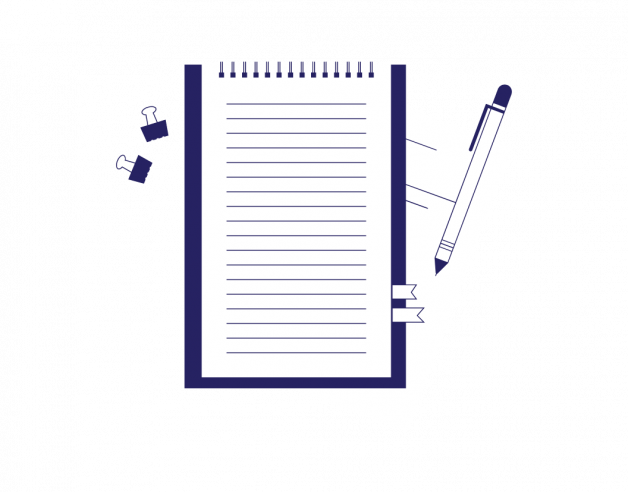
- 2-minute read
- 25th June 2018
The debate over whether the human appendix does anything useful rages on . Much less controversial are the appendices you’ll find in a dissertation or thesis . These are definitely helpful!
However, not every college paper needs an appendix. And if you do include one, you need to make sure you do it right . Here, then, is our guide to using appendices in academic documents.
Do You Need an Appendix?
You will only need appendices in your paper if you have a lot of extra material that doesn’t fit in the main body of the document.
For instance, if you have conducted a survey , you might want to focus on certain data in the Results section of your paper. You can then pick and choose the key information, with the rest given in an appendix. This should be pointed to in the main text as follows:
The full data shows that political engagement is increasing among those aged 18-24 years (see Appendix A).
Your reader would then know to look in “Appendix A” for the survey results. If you do not mention an appendix in the main body of your paper, however, it probably doesn’t need to be there.
Find this useful?
Subscribe to our newsletter and get writing tips from our editors straight to your inbox.
What to Put in Appendices
But what should go in appendices? The usual candidates include:
- Raw test data or results
- Graphs, charts, and tables
- Maps and illustrations
- Letters and emails
- Questionnaires and survey forms
- Interview transcripts
The most important thing is that you only include non-essential information in appendices. If you rely upon something in your arguments, make sure to include it in the main body of your work.
How to Format Appendices
The correct format for appendices will depend on your school’s requirements, so make sure to check your style guide or ask your professor. As a general guideline, though, you should:
- Put appendices after the reference list at the end of your document
- Use a separate appendix for each type of information
- Clearly label each appendix with a letter or number, plus a title that tells the reader what it contains (e.g., Appendix A: Survey Results )
- Include all appendices in the table of contents at the start of your document
If you do all of this, you should have a good set of appendices on your hands! For more information about writing a dissertation or thesis, read our full dissertation writing guide .
Share this article:
Post A New Comment
Got content that needs a quick turnaround? Let us polish your work. Explore our editorial business services.
9-minute read
How to Use Infographics to Boost Your Presentation
Is your content getting noticed? Capturing and maintaining an audience’s attention is a challenge when...
8-minute read

Why Interactive PDFs Are Better for Engagement
Are you looking to enhance engagement and captivate your audience through your professional documents? Interactive...
7-minute read
Seven Key Strategies for Voice Search Optimization
Voice search optimization is rapidly shaping the digital landscape, requiring content professionals to adapt their...
4-minute read
Five Creative Ways to Showcase Your Digital Portfolio
Are you a creative freelancer looking to make a lasting impression on potential clients or...
How to Ace Slack Messaging for Contractors and Freelancers
Effective professional communication is an important skill for contractors and freelancers navigating remote work environments....
3-minute read
How to Insert a Text Box in a Google Doc
Google Docs is a powerful collaborative tool, and mastering its features can significantly enhance your...

Make sure your writing is the best it can be with our expert English proofreading and editing.
- Google Meet
- Mobile Dialer

Resent Search

Management Assignment Writing

Technical Assignment Writing

Finance Assignment Writing

Medical Nursing Writing

Resume Writing

Civil engineering writing

Mathematics and Statistics Projects

CV Writing Service

Essay Writing Service

Online Dissertation Help

Thesis Writing Help

RESEARCH PAPER WRITING SERVICE

Case Study Writing Service

Electrical Engineering Assignment Help

IT Assignment Help

Mechanical Engineering Assignment Help

Homework Writing Help

Science Assignment Writing

Arts Architecture Assignment Help

Chemical Engineering Assignment Help

Computer Network Assignment Help

Arts Assignment Help
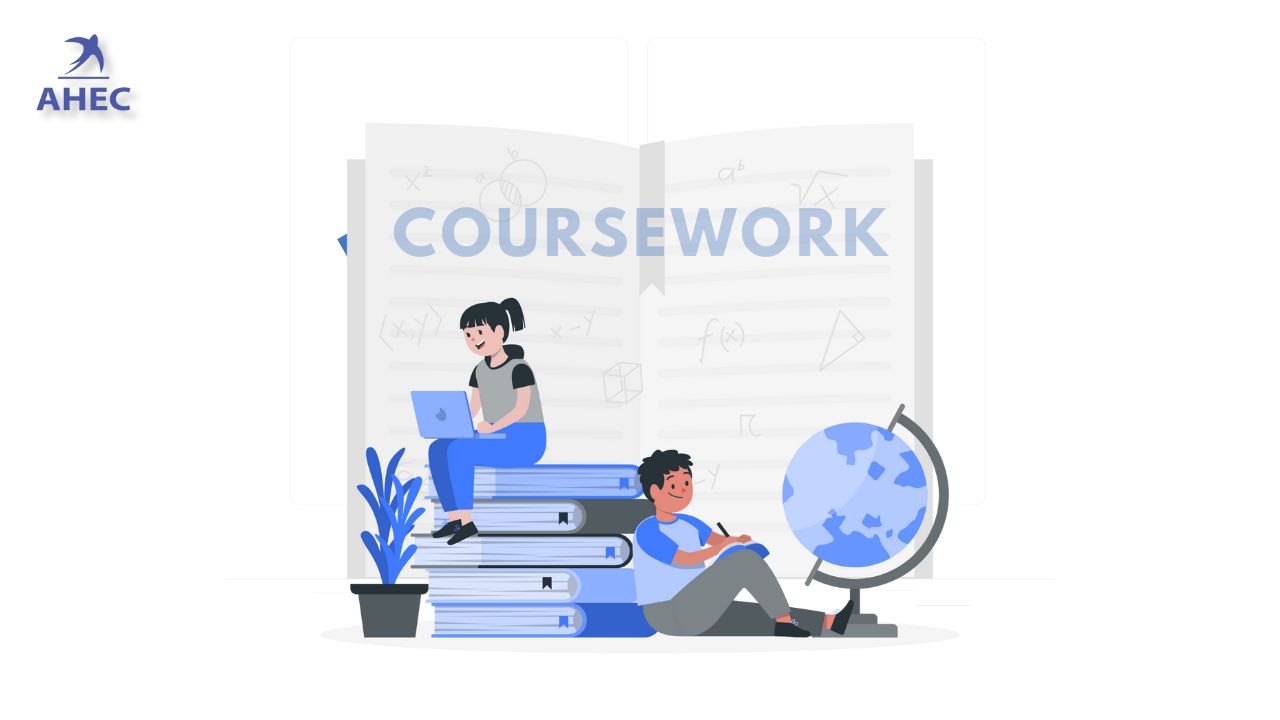
Coursework Writing Help

Custom Paper Writing Services

Personal Statement Writing

Biotechnology Assignment Help

C Programming Assignment Help

MBA Assignment Help

English Essay Writing

MATLAB Assignment Help

Narrative Writing Help

Report Writing Help

Get Top Quality Assignment Assistance

Online Exam Help

Macroeconomics Homework Help
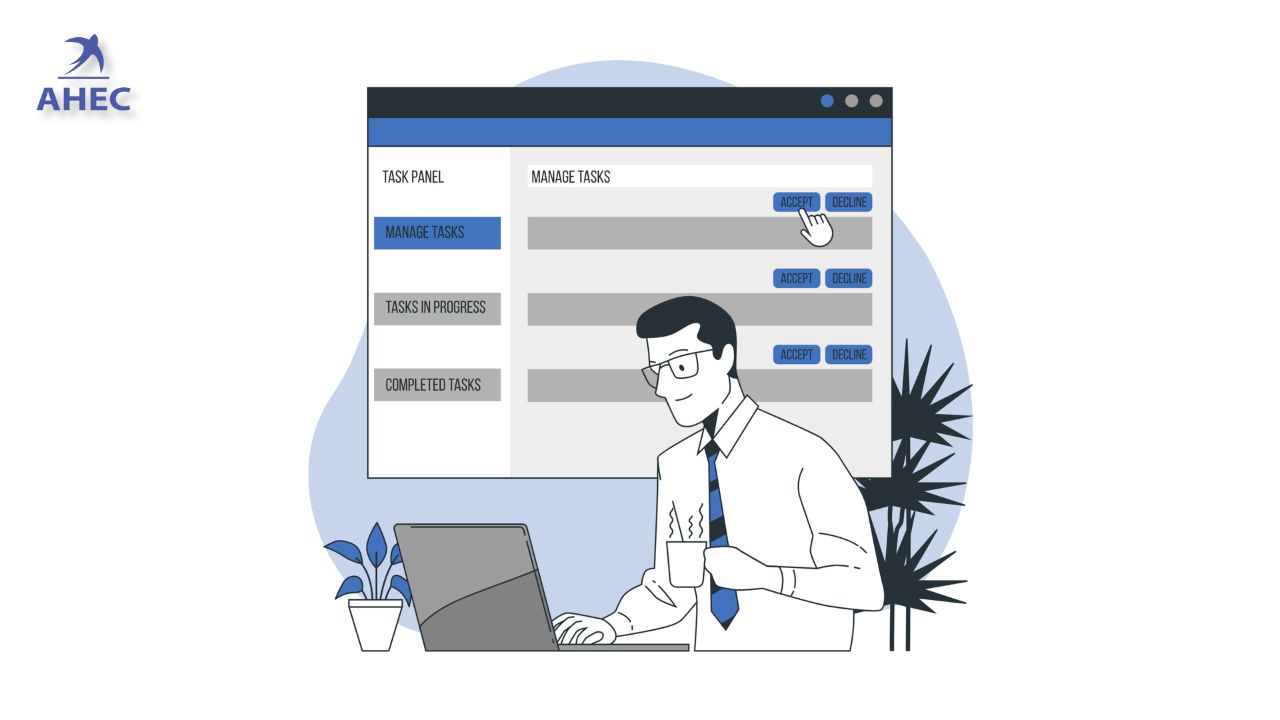
Change Management Assignment Help

Operation management Assignment Help

Strategy Assignment Help

Human Resource Management Assignment Help

Psychology Assignment Writing Help
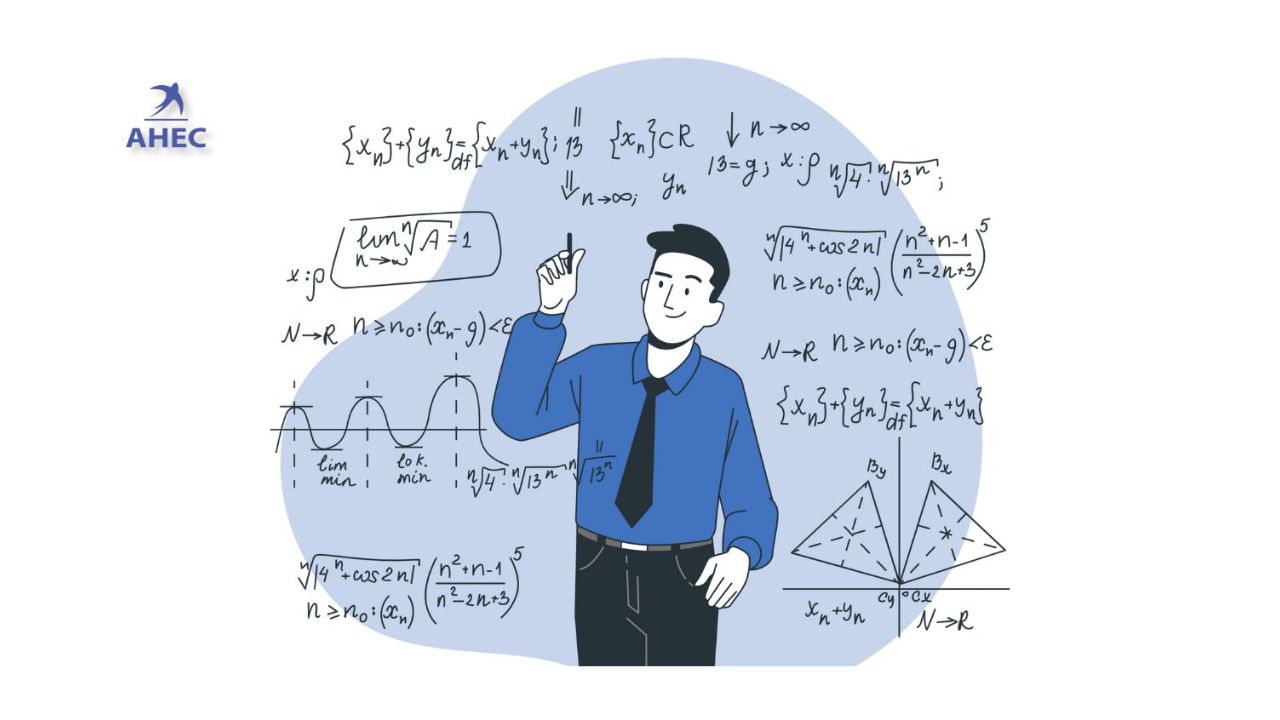
Algebra Homework Help

Best Assignment Writing Tips

Statistics Homework Help

CDR Writing Services

TAFE Assignment Help

Auditing Assignment Help

Literature Essay Help

Online University Assignment Writing

Economics Assignment Help

Programming Language Assignment Help

Political Science Assignment Help

Marketing Assignment Help

Project Management Assignment Help

Geography Assignment Help

Do My Assignment For Me

Business Ethics Assignment Help

Pricing Strategy Assignment Help
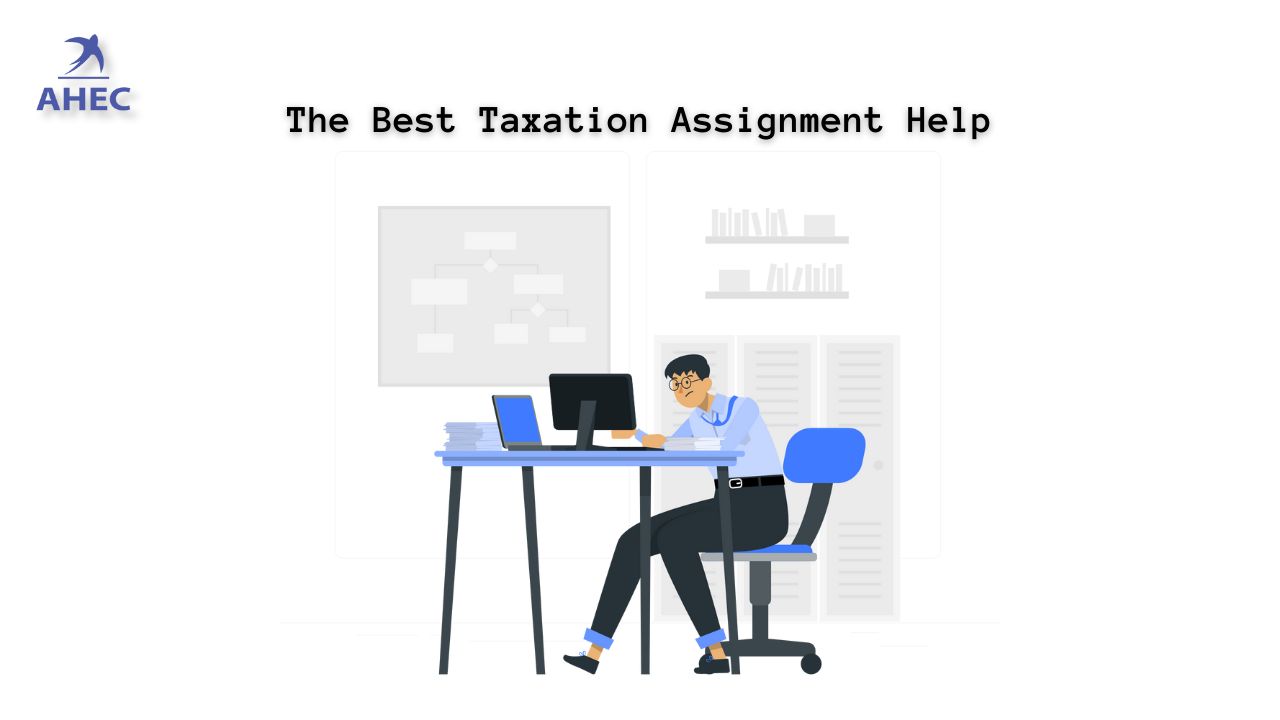
The Best Taxation Assignment Help

Finance Planning Assignment Help

Solve My Accounting Paper Online

Market Analysis Assignment

4p Marketing Assignment Help

Corporate Strategy Assignment Help

Project Risk Management Assignment Help

Environmental Law Assignment Help

History Assignment Help

Geometry Assignment Help

Physics Assignment Help

Clinical Reasoning Cycle

Forex Assignment Help
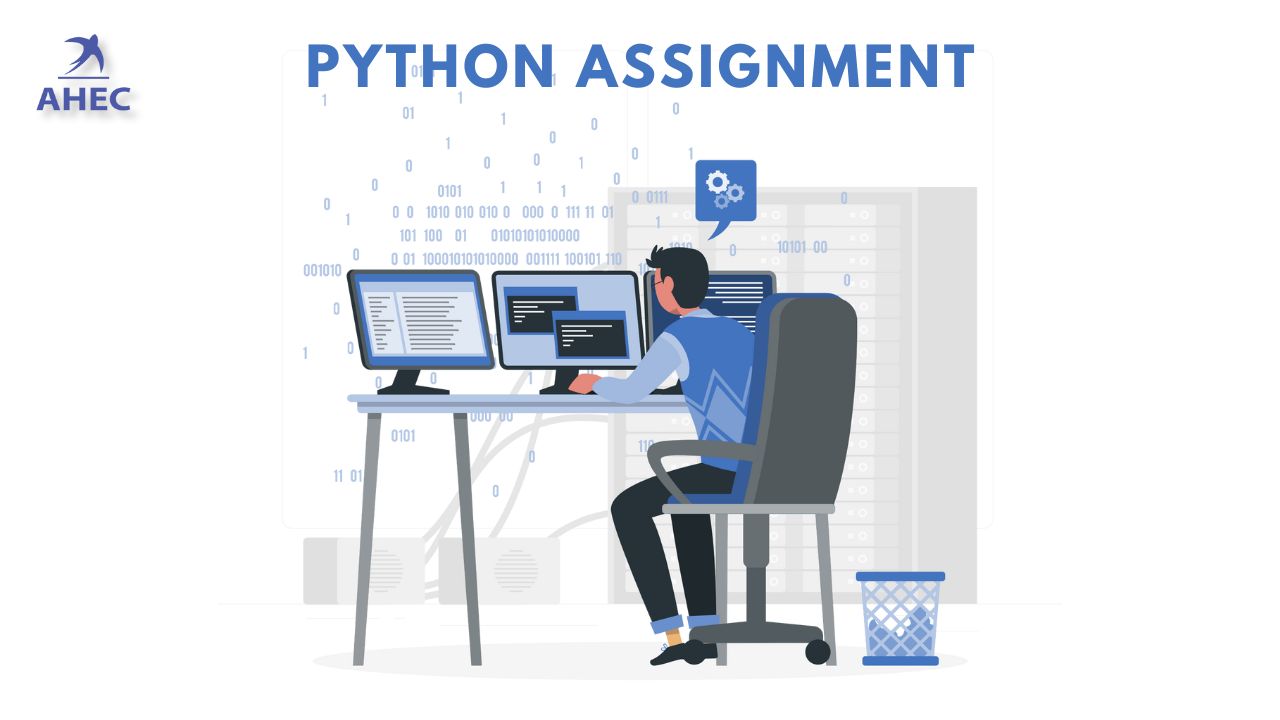
Python Assignment Help

Behavioural Finance Assignment Help

PHP Assignment Help
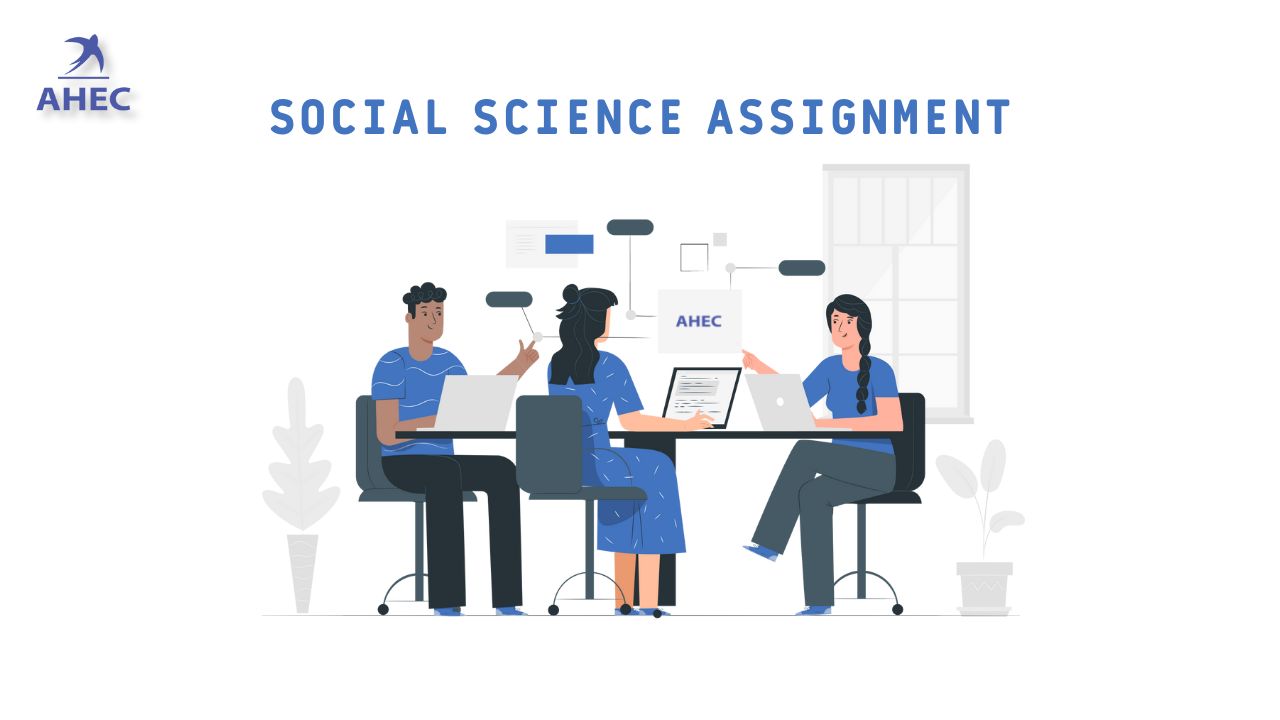
Social Science Assignment Help

Capital Budgeting Assignment Help

Trigonometry Assignment Help

Java Programming Assignment Help

Corporate Finance Planning Help

Sports Science Assignment Help

Accounting For Financial Statements Assignment Help

Robotics Assignment Help

Cost Accounting Assignment Help
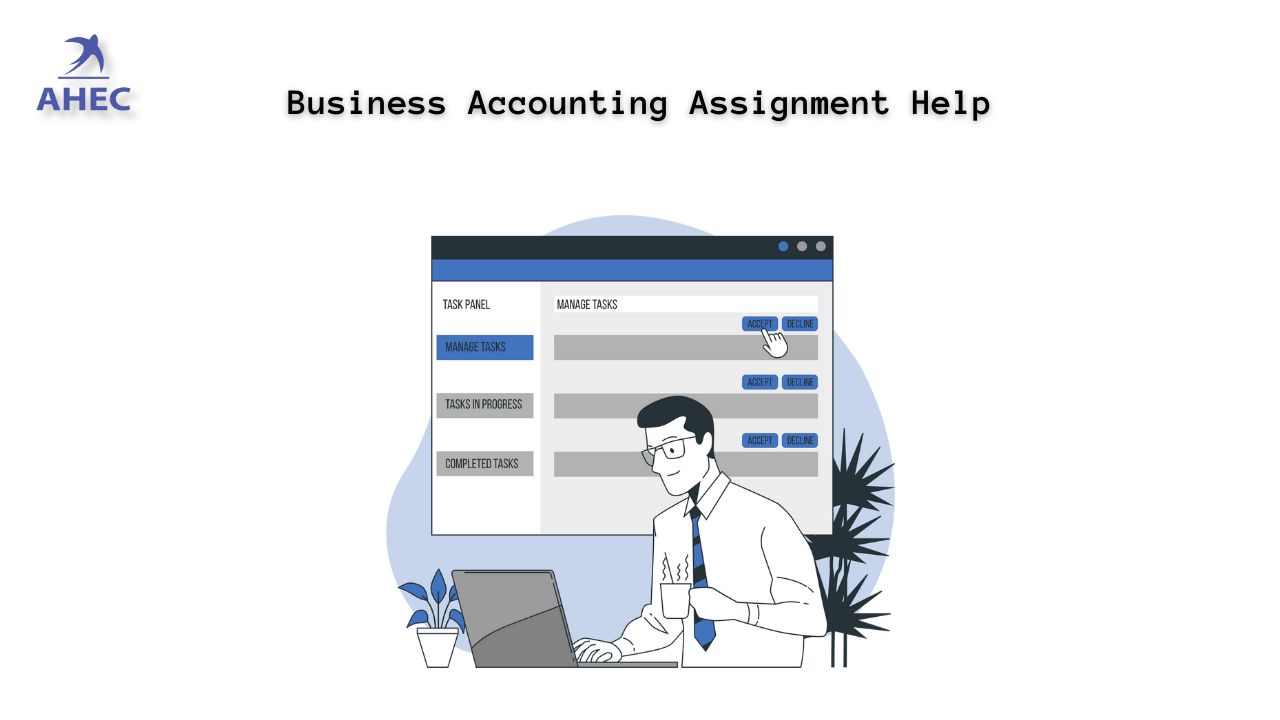
Business Accounting Assignment Help

Activity Based Accounting Assignment Help

Econometrics Assignment Help

Managerial Accounting Assignment Help

R Studio Assignment Help
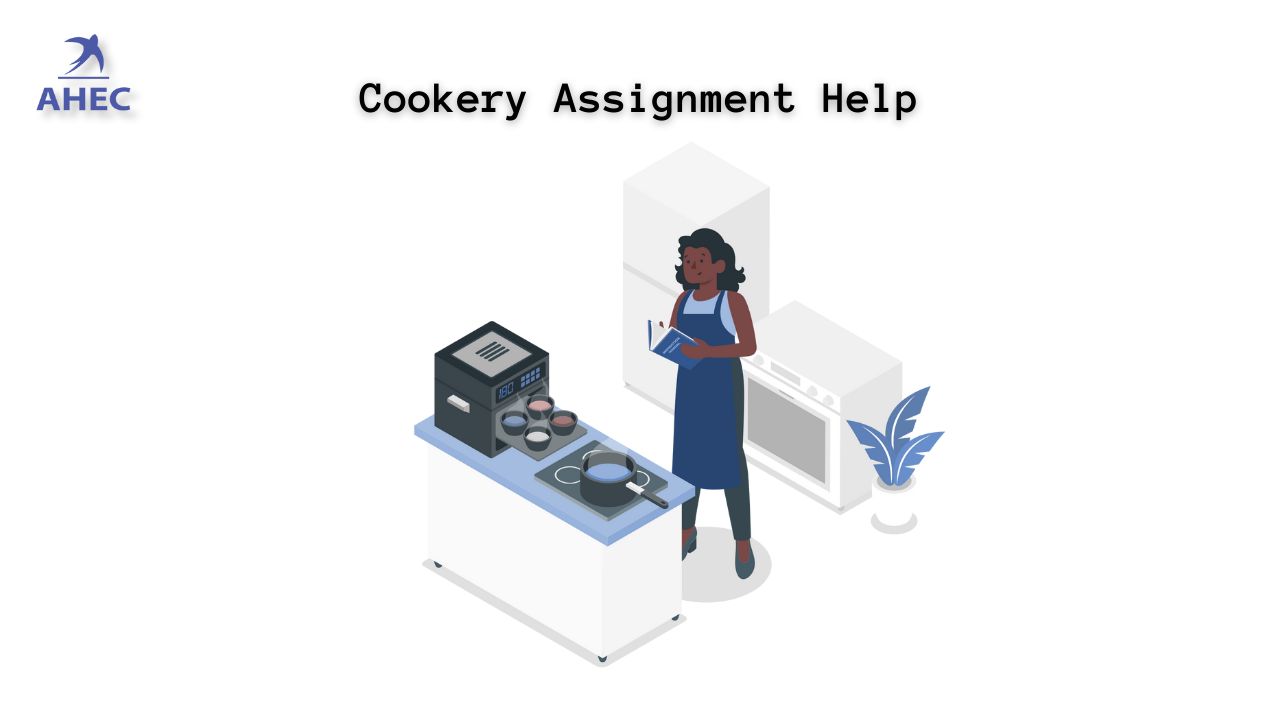
Cookery Assignment Help

Solidworks assignment Help
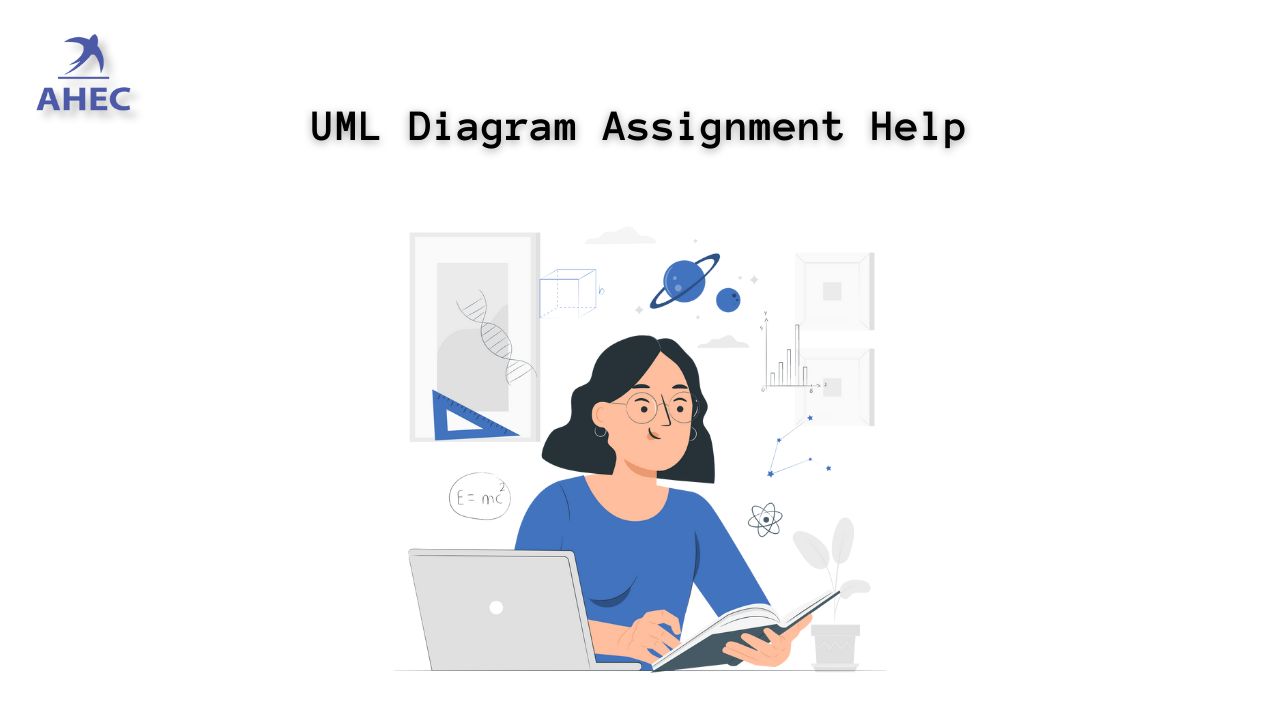
UML Diagram Assignment Help

Data Flow Diagram Assignment Help

Employment Law Assignment Help

Calculus Assignment Help

Arithmetic Assignment Help

Write My Assignment

Business Intelligence Assignment Help

Database Assignment Help

Fluid Mechanics Assignment Help

Web Design Assignment Help

Student Assignment Help

Online CPM Homework Help

Chemistry Assignment Help

Biology Assignment Help

Corporate Governance Law Assignment Help
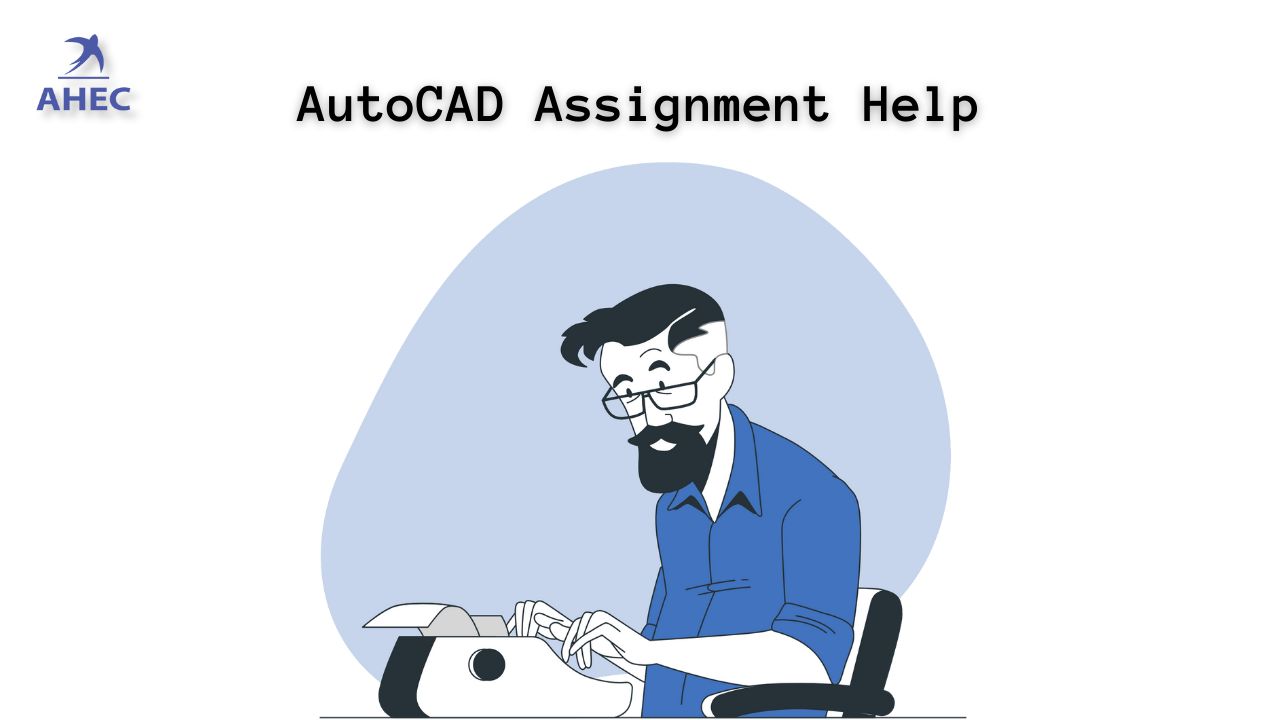
Auto CAD Assignment Help

Public Relations Assignment Help

Bioinformatics Assignment Help
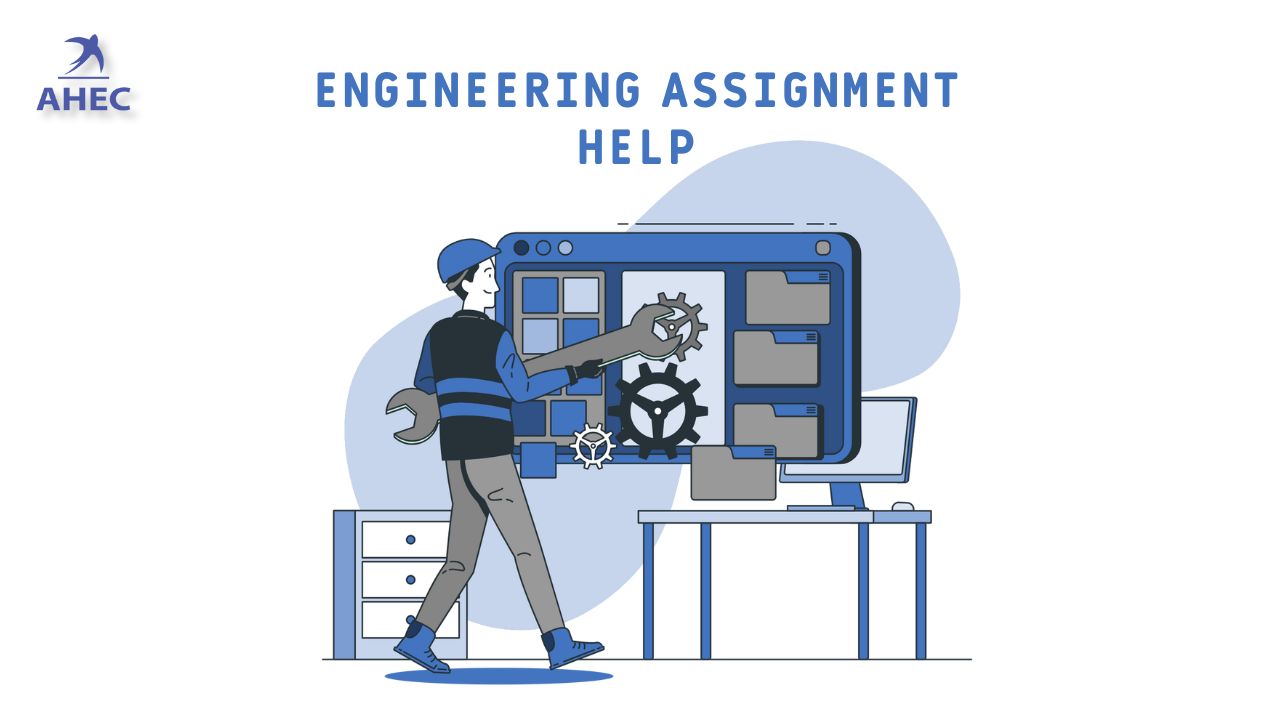
Engineering Assignment Help
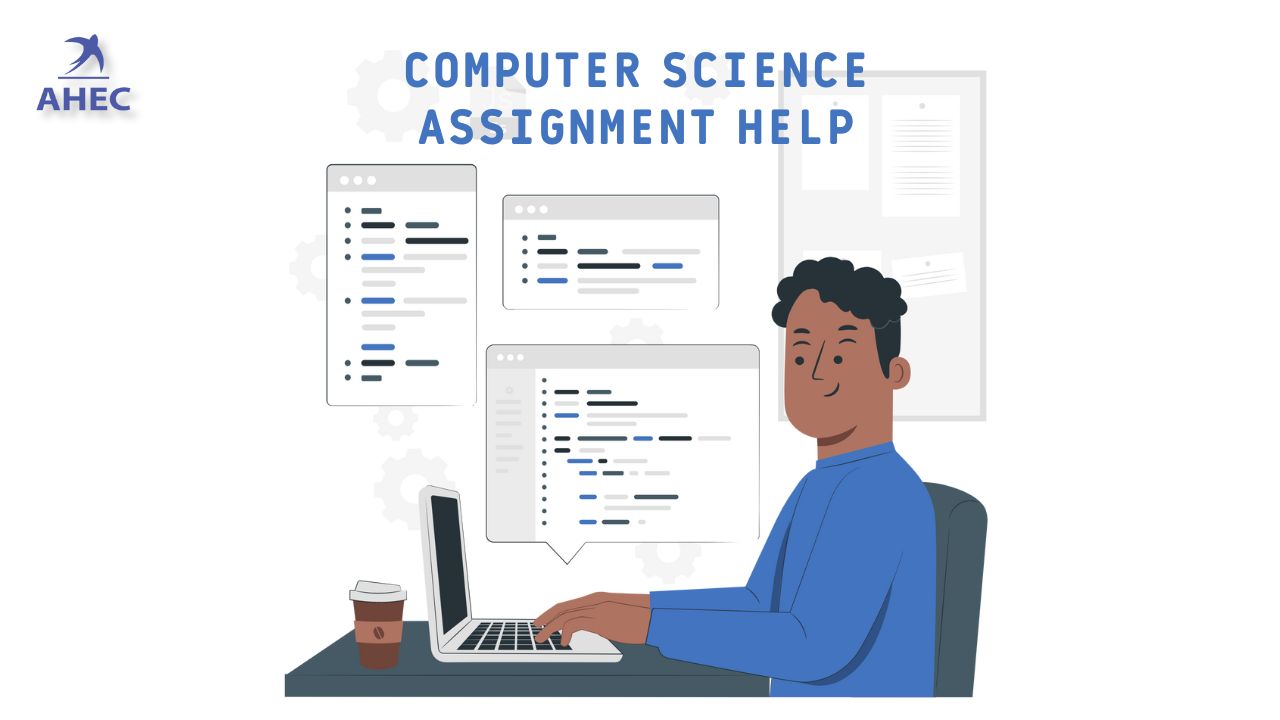
Computer Science Assignment Help

C++ Programming Assignment Help

Aerospace Engineering Assignment Help

Agroecology Assignment Help

Finance Assignment Help

Conflict Management Assignment Help

Paleontology Assignment Help

Commercial Law Assignment Help

Criminal Law Assignment Help

Anthropology Assignment Help

Biochemistry Assignment Help

Get the best cheap assignment Help

Online Pharmacology Course Help

Urgent Assignment Help

Paying For Assignment Help

HND Assignment Help

Legitimate Essay Writing Help

Best Online Proofreading Services

Need Help With Your Academic Assignment
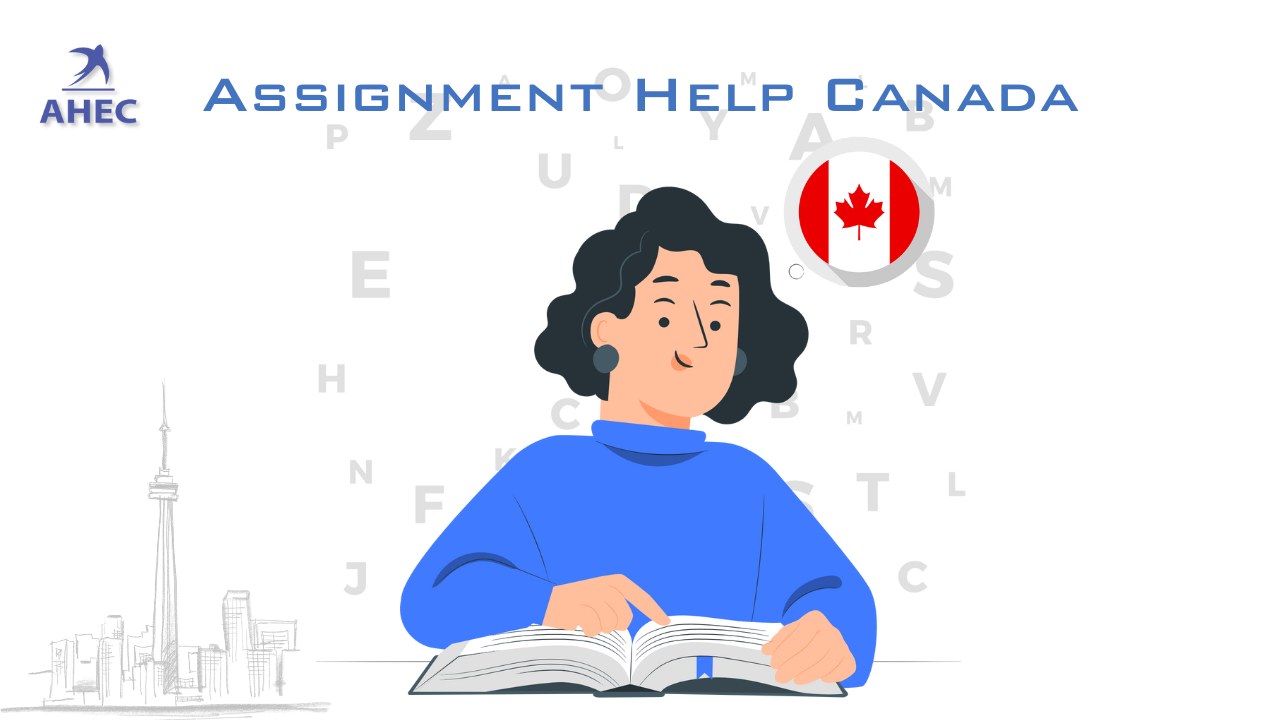
Assignment Writing Help In Canada

Assignment Writing Help In UAE

Online Assignment Writing Help in the USA

Assignment Writing Help In Australia

Assignment Writing Help In the UK

Scholarship Essay Writing Help

University of Huddersfield Assignment Help

Ph.D. Assignment Writing Help

Law Assignment Writing Help

Website Design and Development Assignment Help

University of Greenwich Assignment Assistance in the UK
How to Write Appendices In Academic Writing
Writing appendices can be challenging because, as we know, finding and understanding what they contain can be tricky. Appendices are commonly used in the academic world, and there may be situations where you need to include them in your work. They serve as additional material, including charts, graphs, and other external sources, enhancing your research. Knowing how to write and present them can greatly benefit your academic career. In this blog, we'll discuss what appendices are in academic writing, their purpose, and types, how to structure them, and where to include them in your assignment. Let's dive into the world of “How to Write Appendices”.
What Are Appendices in Academic Writing?
The appendices are a section that you add at the end of an academic paper. This information doesn't belong in the main body; instead, it goes on a separate page. The crucial aspect of appendices is that the extra material must align with the topic, offering relevant and supportive information for the reader. It's important to remember that appendices are not a place for unrelated data; rather, they serve to enhance the understanding of the main content by providing additional context or details. So, ensure that any included information is directly connected to and aids in the comprehension of your academic work.
What Is the Purpose of Appendices?
Understanding the purpose of appendices in academic writing is crucial before delving into how to write them or exploring their types. So, The primary goal of appendices is to provide clear information without confusing the reader. Think of them as a tool to enhance the understanding of your paper; when you have more to explain but are limited by word count, appendices come to the rescue. Here, you can incorporate graphs, charts, or other supplementary materials that go beyond the main text. The core purpose of appendices is to add transparency to the research process. This transparency allows readers to verify and validate the information presented in the main text, fostering trust in the credibility of your work. In essence, the main objective is to provide additional information that enriches comprehension without overwhelming the reader.
What Types of Appendices Are There?
There are so many different kinds of appendices, and each has its unique purpose, offering supplementary material. So, let's explore them.
Spreadsheets
Survey forms, tables and charts.
Maps serve as excellent tools for presenting geographical or location-based information. Whether in the form of traditional paper maps or digital formats, their use depends on the nature of your research and the available technology. They become particularly valuable when your study involves fieldwork or data collection.
Images can enhance the visual appeal of a research paper or report. Visual aids, such as pictures, diagrams, or illustrations, are effective for explaining various concepts. Incorporating images not only breaks up long blocks of text but also adds an interesting and engaging element to your assignment. Their ability to make the content more visually appealing is a key consideration when presenting information.
Raw data stands as the most detailed form of information suitable for inclusion in appendices. It denotes the original data collected during the research process, untouched by analysis or interpretation. The incorporation of raw data in an appendix serves to empower readers, enabling them to independently verify the findings and draw their own conclusions.
Spreadsheets are widely recognized and frequently employed in research for organizing and analyzing data, especially when dealing with extensive databases. Including spreadsheets as appendices enhances readers' comprehension of the data and the calculations conducted, offering a more detailed insight into the research findings.
Survey forms are a valuable inclusion when you want to share the actual forms or questions you used in your research. This provides readers with insight into how you collected your data. These forms typically consist of a set of questions designed to gather data from participants. Including survey forms in an appendix allows readers to grasp the specific questions asked and the response options provided during your research process.
Tables and charts are essential for explaining complex information, making them a common and effective choice in appendices. They serve as a great way to present intricate details, quickly capturing the reader's attention and allowing for a clear comparison of ratios and different groups. Ensure to incorporate tables and charts in your appendices to enhance the understanding of challenging content. comparison.
How to Write and Format Appendices?
How to write appendices.
When writing the appendices, there are a few things you must remember, such as starting with the appendices on a new page, labelling it, writing a clear title, and many other things. Let's examine these points and discover how to write the appendices.
Start a New Page for Each Appendix
Descriptive titles, consistent formatting, page numbering, content inclusion, format the appendices, review and edit.
The very first step in writing an appendice is to start with a new page for every appendix. this will help the reader to read and understand it more quickly and the separating will look organized so make sure to start every appendix on a new page.
Labelling the appendices is great cause you need to ensure that the appendices involve assigning clear labels to each of them so make sure to write them like Appendix A or Appendix 1 and labelling them makes you and the reader less confused.
Each appendix should have a descriptive title that must be more appealing also make sure to write it in bold so that can be seen clearly. This will help the reader understand the purpose of the appendix and its relevance to the main text.
Maintaining consistent formatting is so useful so you need to make sure that you use the same font, and the same margins written out of style can provide you with great organised content. so make sure to maintain it.
You can simply set the page number cause including the page numbers in your appendices to make it easier for the reader to find the information, so make sure to remember to continue the page numbering from the main text Don't confuse yourself and the reader.
In the process of creating appendices, content inclusion is a critical step. It involves adding supplementary materials such as charts, graphs, tables, or any relevant additional information that supports and enhances the main text. providing a comprehensive understanding of your research or information.
Make sure to In APA style, appendices should be formatted in traditional paragraph style and may incorporate text, figures, tables etc so make sure to add the formatting style.
After content inclusion and formatting, a thorough review and editing are necessary. This stage involves carefully assessing the content for clarity, relevance, and accuracy. so make sure to find the places to make changes and edit according to that.
The final step in preparing appendices is the proofreading stage. Proofreading ensures that the content is polished and error-free, contributing to a professional and well-presented document. Taking the time to proofread is crucial for delivering a document that reflects a high standard of quality and attention to detail.
Formatting Appendices In Different Styles
If we examine the format of appendices, we find various styles, with three main formats to keep in mind: APA, MLA, and Chicago. Let's delve into the specific writing formats for each in the sections below.
In APA style, when composing your appendices, ensure that the text is left-aligned for body paragraphs. Page numbers should be consistently placed in the upper right corner of each page for easy reference. Figures and tables within the appendices must be labeled with the corresponding appendix letter followed by a numerical sequence, such as in Figure A1.
When adhering to MLA style for your appendices, adopt block quotations (indented by 10 spaces) for lengthy text passages. Page numbers should be centered at the bottom of each page within the appendices. Figures and tables, regardless of the specific appendix, should be numbered individually using Arabic numerals, such as Figure 1 or Table 2.
Chicago Style
In Chicago style, ensure that the first line of each paragraph within the appendices features hanging indentations. Page numbers should be added in the lower right corner of each appendix page. Figures and tables, irrespective of the specific appendix, should be numbered separately using Arabic numerals, like Figure 1.
Where to Include Appendices in an Assignment?
Appendices should be included at the end of the assignment, and you must include them at the end of your reference list. and every appendix must be aligned with the citation, table, or figures that are included after the paper. additionally, if you have an excessive number of appendices, be sure to include them separately.
Finally, we reviewed how to write appendices and how they might help improve academic writing. We've looked at an array of types, including tables, charts, and raw data, and we grasp their function to offer more context and help. We've covered the basics of creating well-structured and interesting appendices that complement the main content seamlessly.

Top 10 Best Universities Ranking list in India 2022

Generic Conventions: Assignment Help Services

Research Paper Topics For Medical

Top 5 Resources for Writing Excellent Academic Assignments

How to Write a Literature Review for Academic Purposes

Tips for Writing a killer introduction to your assignment

How To Write A Compelling Conclusion For Your University Assignment

Research Papers Topics For Social Science

Best 150 New Research Paper Ideas For Students

7 Best Plagiarism Checkers for Students And Teachers in 2024
Enquiry form.
- USC Libraries
- Research Guides
Organizing Your Social Sciences Research Paper
- Purpose of Guide
- Design Flaws to Avoid
- Independent and Dependent Variables
- Glossary of Research Terms
- Reading Research Effectively
- Narrowing a Topic Idea
- Broadening a Topic Idea
- Extending the Timeliness of a Topic Idea
- Academic Writing Style
- Applying Critical Thinking
- Choosing a Title
- Making an Outline
- Paragraph Development
- Research Process Video Series
- Executive Summary
- The C.A.R.S. Model
- Background Information
- The Research Problem/Question
- Theoretical Framework
- Citation Tracking
- Content Alert Services
- Evaluating Sources
- Primary Sources
- Secondary Sources
- Tiertiary Sources
- Scholarly vs. Popular Publications
- Qualitative Methods
- Quantitative Methods
- Insiderness
- Using Non-Textual Elements
- Limitations of the Study
- Common Grammar Mistakes
- Writing Concisely
- Avoiding Plagiarism
- Footnotes or Endnotes?
- Further Readings
- Generative AI and Writing
- USC Libraries Tutorials and Other Guides
- Bibliography
An appendix contains supplementary material that is not an essential part of the text itself but which may be helpful in providing a more comprehensive understanding of the research problem. An appendix may also contain information that is too cumbersome to be included in the body of the paper. A separate appendix should be used for each distinct topic or set of data and always have a title descriptive of its contents [e.g., Appendix 1: Interview Protocol].
Tables, Appendices, Footnotes and Endnotes. The Writing Lab and The OWL. Purdue University.
Importance of...
Appendices are always supplementary to the research paper. As such, your study must be able to stand alone without the appendices, and the paper must contain all information including tables, diagrams, and results necessary to understand the research problem. The key point to remember when including an appendix or appendices is that the information is non-essential to understanding the research problem being investigated. In other words, if it were removed, the reader would still be able to comprehend the significance, validity , and implications of your research even if that additional data was missing.
It is appropriate to include appendices for the following reasons:
- Including this material in the body of the paper that would render it poorly structured or interrupt the narrative flow;
- Information is too lengthy and detailed to be easily summarized in the body of the paper;
- Inclusion of helpful, supporting, or useful material would otherwise distract the reader from the main content of the paper;
- Provides relevant information or data that is more easily understood or analyzed in a self-contained section of the paper;
- Can be used when there are constraints placed on the length of your paper; and,
- Provides a place to further demonstrate your understanding of the research problem by giving additional details about a new or innovative method, technical details, or design protocols.
Appendices. Academic Skills Office, University of New England; Chapter 12, "Use of Appendices." In Guide to Effective Grant Writing: How to Write a Successful NIH Grant . Otto O. Yang. (New York: Kluwer Academic, 2005), pp. 55-57; Tables, Appendices, Footnotes and Endnotes. The Writing Lab and The OWL. Purdue University.
Structure and Writing Style
I. General Points to Consider
When considering whether to include content in an appendix, keep in mind the following:
- It is usually good practice to include your raw data in an appendix, laying it out in a clear format so the reader can re-check your results. Another option if you have a large amount of raw data is to consider placing it online [e.g., on a Google drive] and note that this is the appendix to your research paper.
- Any tables and figures included in the appendix should be numbered as a separate sequence from the main paper . Remember that appendices contain non-essential information that, if removed, would not diminish a reader's ability to understand the research problem being investigated. This is why non-textual elements should not carry over the sequential numbering of non-textual elements in the body of your paper.
- If you have more than three appendices, consider listing them on a separate page in the table of contents . This will help the reader know what information is included in the appendices. Note that some works list appendices in the table of contents before the first chapter while other styles list the appendices after the conclusion but before your references. Consult with your professor to confirm if there is a preferred approach.
- The appendix can be a good place to put maps, photographs, diagrams, and other images , if you feel that it will help the reader to understand the content of your paper, while keeping in mind the study should be understood without them.
- An appendix should be streamlined and not loaded with a lot information . If you have a very long and complex appendix, it is a good idea to break it down into separate appendices, allowing the reader to find relevant information quickly as the information is covered in the body of the paper.
II. Content
Never include an appendix that isn’t referred to in the text . All appendices should be summarized in your paper where it is relevant to the content. Appendices should also be arranged sequentially by the order they were first referenced in the text [i.e., Appendix 1 should not refer to text on page eight of your paper and Appendix 2 relate to text on page six].
There are few rules regarding what type of material can be included in an appendix, but here are some common examples:
- Correspondence -- if your research included collaborations with others or outreach to others, then correspondence in the form of letters, memorandums, or copies of emails from those you interacted with could be included.
- Interview Transcripts -- in qualitative research, interviewing respondents is often used to gather information. The full transcript from an interview is important so the reader can read the entire dialog between researcher and respondent. The interview protocol [list of questions] should also be included.
- Non-textual elements -- as noted above, if there are a lot of non-textual items, such as, figures, tables, maps, charts, photographs, drawings, or graphs, think about highlighting examples in the text of the paper but include the remainder in an appendix.
- Questionnaires or surveys -- this is a common form of data gathering. Always include the survey instrument or questionnaires in an appendix so the reader understands not only the questions asked but the sequence in which they were asked. Include all variations of the instruments as well if different items were sent to different groups [e.g., those given to teachers and those given to administrators] .
- Raw statistical data – this can include any numerical data that is too lengthy to include in charts or tables in its entirety within the text. This is important because the entire source of data should be included even if you are referring to only certain parts of a chart or table in the text of your paper.
- Research instruments -- if you used a camera, or a recorder, or some other device to gather information and it is important for the reader to understand how, when, and/or where that device was used.
- Sample calculations – this can include quantitative research formulas or detailed descriptions of how calculations were used to determine relationships and significance.
NOTE: Appendices should not be a dumping ground for information. Do not include vague or irrelevant information in an appendix; this additional information will not help the reader’s overall understanding and interpretation of your research and may only distract the reader from understanding the significance of your overall study.
ANOTHER NOTE: Appendices are intended to provide supplementary information that you have gathered or created; it is not intended to replicate or provide a copy of the work of others. For example, if you need to contrast the techniques of analysis used by other authors with your own method of analysis, summarize that information, and cite to the original work. In this case, a citation to the original work is sufficient enough to lead the reader to where you got the information. You do not need to provide a copy of this in an appendix.
III. Format
Here are some general guideline on how to format appendices . If needed, consult the writing style guide [e.g., APA, MLS, Chicago] your professor wants you to use for more detail or choose the style you are most familiar with:
- Appendices may precede or follow your list of references.
- Each appendix begins on a new page.
- The order they are presented is dictated by the order they are mentioned in the text of your research paper.
- The heading should be "Appendix," followed by a letter or number [e.g., "Appendix A" or "Appendix 1"], centered and written in bold type.
- If there is a table of contents, the appendices must be listed.
- Depending on the type of information, the content can be presented in landscape format rather than regular portrait format.
- The page number(s) of the appendix/appendices will continue on with the numbering from the last page of the text.
Appendices. The Structure, Format, Content, and Style of a Journal-Style Scientific Paper. Department of Biology. Bates College; Appendices. Academic Skills Office, University of New England; Appendices. Writing Center, Walden University; Chapter 12, "Use of Appendices." In Guide to Effective Grant Writing: How to Write a Successful NIH Grant . Otto O. Yang. (New York: Kluwer Academic, 2005), pp. 55-57 ; Tables, Appendices, Footnotes and Endnotes. The Writing Lab and The OWL. Purdue University; Lunsford, Andrea A. and Robert Connors. The St. Martin's Handbook . New York: St. Martin's Press, 1989; What To Know About The Purpose And Format Of A Research Paper Appendix. LoyolaCollegeCulion.com.
Writing Tip
Consider Putting Your Appendices Online
Appendices are useful because they provide the reader with information that supports your study without breaking up the narrative or distracting from the main purpose of your paper. If you have a lot of raw data or information that is difficult to present in textual form, consider uploading it to an online site. This prevents your paper from having a large and unwieldy set of appendices and it supports a growing movement within academe to make data more freely available for re-analysis. If you do create an online portal to your data, note it prominently in your paper with the correct URL and access procedures if it is a secured site, or if needed, with clear directions on how to contact the author to obtain access.
Piwowar, Heather A., Roger S. Day, and Douglas B. Fridsma. “Sharing Detailed Research Data Is Associated with Increased Citation Rate.” PloS ONE (March 21, 2007); Wicherts, Jelte M., Marjan Bakker, and Dylan Molenaar. “Willingness to Share Research Data Is Related to the Strength of the Evidence and the Quality of Reporting of Statistical Results.” PLoS ONE (November 2, 2011).
- << Previous: 9. The Conclusion
- Next: 10. Proofreading Your Paper >>
- Last Updated: Jun 18, 2024 10:45 AM
- URL: https://libguides.usc.edu/writingguide

An appendix** comes at the end (after the reference list) of a report, research project, or dissertation and contains any additional information such as raw data or interview transcripts. The information in the appendices is relevant but is too long or too detailed to include in the main body of your work.
**Note: Appendix is singular and appendices is plural. When you want to refer to one of your appendices, use appendix - for example, ‘See Appendix 1’.
Scroll down for our recommended strategies and resources.
Ensure everything in your appendices has a purpose. This guide gives a useful overview of the structure, format, and effective use of appendices:
Appendices (University of Southern California)
Your appendices should have a clear labelling system (Appendix 1, Appendix 2, Appendix 3) and each item in an appendix should have a descriptive title saying what it is (‘Appendix 1: Flowchart of purchasing decision-making process).
You need to refer to your appendices in the body of your assignment or the reader will not know they are there. Use a short phrase such as ‘See Appendix 1’.
If you have taken data, diagrams, or information from other sources to put in your appendices, you need to reference them as normal; include an in-text citation next to the item in your appendices and a full reference in your reference list. If you have created your own graphs or tables using data from another source you can explain this in your in-text citation: (Table author’s own, data from Jones, 2017).
Back to top
Cookie statement
- Privacy Policy

Home » Appendices – Writing Guide, Types and Examples
Appendices – Writing Guide, Types and Examples
Table of Contents

Definition:
Appendices refer to supplementary materials or documents that are attached to the end of a Book, Report , Research Paper , Thesis or other written work. These materials can include charts, graphs, tables, images, or other data that support the main content of the work.
Types of Appendices
Types of appendices that can be used depending on the content and purpose of the document. These types of Appendices are as follows:
Statistical Appendices
Statistical appendices are used to present raw data or statistical analysis that is relevant to the main text but would be too bulky to include in the main body of the document. These appendices may include tables, graphs, charts, or other types of visual aids that help to illustrate the data.
Technical Appendices
Technical appendices are used to provide detailed technical information that is relevant to the main text but would be too complex or lengthy to include in the main body of the document. These appendices may include equations, formulas, diagrams, or other technical details that are important for understanding the subject matter.
Bibliographical Appendices
Bibliographical appendices are used to provide additional references or sources that are relevant to the main text but were not cited in the main body of the document. These appendices may include lists of books, articles, or other resources that the author consulted in the course of their research.
Historical Appendices
Historical appendices are used to provide background information or historical context that is relevant to the main text but would be too lengthy or distracting to include in the main body of the document. These appendices may include timelines, maps, biographical sketches, or other historical details that help to contextualize the subject matter.
Supplemental Appendices
Supplemental appendices are used to provide additional material that is relevant to the main text but does not fit into any of the other categories. These appendices may include interviews, surveys, case studies, or other types of supplemental material that help to further illustrate the subject matter.
Applications of Appendices
Some applications of appendices are:
- Providing detailed data and statistics: Appendices are often used to include detailed data and statistics that support the findings presented in the main body of the document. For example, in a research paper, an appendix might include raw data tables or graphs that were used to support the study’s conclusions.
- Including technical details: Appendices can be used to include technical details that may be of interest to a specialized audience. For example, in a technical report, an appendix might include detailed calculations or equations that were used to develop the report’s recommendations.
- Presenting supplementary information: Appendices can be used to present supplementary information that is related to the main content but doesn’t fit well within the main body of the document. For example, in a business proposal, an appendix might include a list of references or a glossary of terms.
- Providing supporting documentation: Appendices can be used to provide supporting documentation that is required by the document’s audience. For example, in a legal document, an appendix might include copies of contracts or agreements that were referenced in the main body of the document.
- Including multimedia materials : Appendices can be used to include multimedia materials that supplement the main content. For example, in a book, an appendix might include photographs, maps, or illustrations that help to clarify the text.
Importance of Appendices
Appendices are important components of research papers, reports, Thesis, and other academic papers. They are supplementary materials that provide additional information and data that support the main text. Here are some reasons why appendices are important:
- Additional Information : Appendices provide additional information that is too detailed or too lengthy to include in the main text. This information includes raw data, graphs, tables, and charts that support the research findings.
- Clarity and Conciseness : Appendices help to maintain the clarity and conciseness of the main text. By placing detailed information and data in appendices, writers can avoid cluttering the main text with lengthy descriptions and technical details.
- Transparency : Appendices increase the transparency of research by providing readers with access to the data and information used in the research process. This transparency increases the credibility of the research and allows readers to verify the findings.
- Accessibility : Appendices make it easier for readers to access the data and information that supports the research. This is particularly important in cases where readers want to replicate the research or use the data for their own research.
- Compliance : Appendices can be used to comply with specific requirements of the research project or institution. For example, some institutions may require researchers to include certain types of data or information in the appendices.
Appendices Structure
Here is an outline of a typical structure for an appendix:
I. Introduction
- A. Explanation of the purpose of the appendix
- B. Brief overview of the contents
II. Main Body
- A. Section headings or subheadings for different types of content
- B. Detailed descriptions, tables, charts, graphs, or images that support the main content
- C. Labels and captions for each item to help readers navigate and understand the content
III. Conclusion
- A. Summary of the key points covered in the appendix
- B. Suggestions for further reading or resources
IV. Appendices
- A. List of all the appendices included in the document
- B. Table of contents for the appendices
V. References
- A. List of all the sources cited in the appendix
- B. Proper citation format for each source
Example of Appendices
here’s an example of what appendices might look like for a survey:
Appendix A:
Survey Questionnaire
This section contains a copy of the survey questionnaire used for the study.
- What is your age?
- What is your gender?
- What is your highest level of education?
- How often do you use social media?
- Which social media platforms do you use most frequently?
- How much time do you typically spend on social media each day?
- Do you feel that social media has had a positive or negative impact on your life?
- Have you ever experienced cyberbullying or harassment on social media?
- Have you ever been influenced by social media to make a purchase or try a new product?
- In your opinion, what are the biggest advantages and disadvantages of social media?
Appendix B:
Participant Demographics
This section includes a table with demographic information about the survey participants, such as age, gender, and education level.
Age Gender Education Level
- 20 Female Bachelor’s Degree
- 32 Male Master’s Degree
- 45 Female High School Diploma
- 28 Non-binary Associate’s Degree
Appendix C:
Statistical Analysis
This section provides details about the statistical analysis performed on the survey data, including tables or graphs that illustrate the results of the analysis.
Table 1: Frequency of Social Media Platforms
Use Platform Frequency
- Facebook 35%
- Instagram 28%
- Twitter 15%
- Snapchat 12%
Figure 1: Impact of Social Media on Life Satisfaction
Appendix D:
Survey Results
This section presents the raw data collected from the survey, such as participant responses to each question.
Question 1: What is your age?
Question 2: What is your gender?
And so on for each question in the survey.
How to Write Appendices
Here are the steps to follow to write appendices:
- Determine what information to include: Before you start writing your appendices, decide what information you want to include. This may include tables, figures, graphs, charts, photographs, or other types of data that support the main content of your paper.
- Organize the material: Once you have decided what to include, organize the material in a logical manner that follows the sequence of the main content. Use clear headings and subheadings to make it easy for readers to navigate through the appendices.
- Label the appendices: Label each appendix with a capital letter (e.g., “Appendix A,” “Appendix B,” etc.) and provide a brief descriptive title that summarizes the content.
- F ormat the appendices: Follow the same formatting style as the rest of your paper or report. Use the same font, margins, and spacing to maintain consistency.
- Provide detailed explanations: Make sure to provide detailed explanations of any data, charts, graphs, or other information included in the appendices so that readers can understand the significance of the material.
- Cross-reference the appendices: In the main text, cross-reference the appendices where appropriate by referring to the appendix letter and title (e.g., “see Appendix A for more information”).
- Review and revise: Review and revise the appendices just as you would any other part of your paper or report to ensure that the information is accurate, clear, and relevant.
When to Write Appendices
Appendices are typically included in a document when additional information needs to be provided that is not essential to the main text, but still useful for readers who want to delve deeper into a topic. Here are some common situations where you might want to include appendices:
- Supporting data: If you have a lot of data that you want to include in your document, but it would make the main text too lengthy or confusing, you can include it in an appendix. This is especially useful for academic papers or reports.
- Additional examples: I f you want to include additional examples or case studies to support your argument or research, but they are not essential to the main text, you can include them in an appendix.
- Technical details: I f your document contains technical information that may be difficult for some readers to understand, you can include detailed explanations or diagrams in an appendix.
- Background information : If you want to provide background information on a topic that is not directly related to the main text, but may be helpful for readers, you can include it in an appendix.
Purpose of Appendices
The purposes of appendices include:
- Providing additional details: Appendices can be used to provide additional information that is too detailed or bulky to include in the main body of the document. For example, technical specifications, data tables, or lengthy survey results.
- Supporting evidence: Appendices can be used to provide supporting evidence for the arguments or claims made in the main body of the document. This can include supplementary graphs, charts, or other visual aids that help to clarify or support the text.
- Including legal documents: Appendices can be used to include legal documents that are referred to in the main body of the document, such as contracts, leases, or patent applications.
- Providing additional context: Appendices can be used to provide additional context or background information that is relevant to the main body of the document. For example, historical or cultural information, or a glossary of technical terms.
- Facilitating replication: In research papers, appendices are used to provide detailed information about the research methodology, raw data, or analysis procedures to facilitate replication of the study.
Advantages of Appendices
Some Advantages of Appendices are as follows:
- Saving Space: Including lengthy or detailed information in the main text of a document can make it appear cluttered and overwhelming. By placing this information in an appendix, it can be included without taking up valuable space in the main text.
- Convenience: Appendices can be used to provide supplementary information that is not essential to the main argument or discussion but may be of interest to some readers. By including this information in an appendix, readers can choose to read it or skip it, depending on their needs and interests.
- Organization: Appendices can be used to organize and present complex information in a clear and logical manner. This can make it easier for readers to understand and follow the main argument or discussion of the document.
- Compliance : In some cases, appendices may be required to comply with specific document formatting or regulatory requirements. For example, research papers may require appendices to provide detailed information on research methodology, data analysis, or technical procedures.
About the author
Muhammad Hassan
Researcher, Academic Writer, Web developer
You may also like

Research Paper Format – Types, Examples and...

Critical Analysis – Types, Examples and Writing...

References in Research – Types, Examples and...

Assignment – Types, Examples and Writing Guide

Theoretical Framework – Types, Examples and...

Future Research – Thesis Guide

1. Researching, Writing and Presenting Information - A How To Guide: How to use Appendices
- Brainstorming and Planning
- Effective Research
- Note-taking
- Writing an Essay
- Writing a Discussion
- Writing an Exposition
- Writing a Rationale
- Years 11 & 12
- Writing a Blog Post
- Writing a Feature Article
- Preparing Oral Presentations
- Creating a Podcast
- Technologies
- Effective Proofreading Skills
- Glossary of Common Instruction Terms
- Glossary of Literary Terms
- How to use Appendices
- How to paraphrase
What are Appendices and how should they be used?
For some tasks, you may be asked to include parts of your work in an a ppendix or appendices (plural).
Usually an appendix is used to include extra information or research that is useful but too detailed and not necessary to include within the report, but that you would like to include at the end of the report to show the marker that you have completed it.
Examples - This might include interview or survey results, detailed technical drawings, or tables of data collected.
Sometimes an appendix may be used for ESSENTIAL tables and figures which are too large to fit into the text of an essay/report.
The conventions for appendices are as follows:
- each appendix must be labelled with a number (or letter) and title e.g. Appendix A : Cross Sectional Data Set
- there should be a page break between Appendix A, B etc.
- the appendix numbers and titles must be listed on the Contents page of your report under the heading Appendices (if more than one) or Appendix (if only one)
- The content should be summarised and each appendix must be referred to by number (or letter) at the relevant point within the report e.g. " Survey results indicated that most respondents aged 14 - 16 had worked casually or would like to work casually in the near future (see Appendix D)" This prompts the marker to look at Appendix D for a detailed presentation of these survey results either in the form of a graph or a table.
How to create an appendix
- << Previous: Glossary of Literary Terms
- Next: How to paraphrase >>
- Last Updated: Sep 15, 2022 2:24 PM
- URL: https://stcc.libguides.com/c.php?g=926682
What Is An Appendix And How To Write Effective Appendix?

The section of the appendix would help a person in grasping the idea of what data have been used in drafting the same academic assignment. Since it is a necessary part of an academic paper, certain rules should be followed in drafting an appendix in the paper. The style of drafting the appendix would depend on the guidelines provided by the tutor of the student. This article on what is an appendix is mainly intended to provide the student with clarity over how to draft an appendix and the significance of it to be included in the academic paper. We have discussed in this article on “what is an appendix” regarding various styles of drafting like MLA, Chicago, and APA style of drafting.
Subscribe our YouTube channel for more related videos
What is an appendix? It is one of the major doubts of the students on campus that actually is an appendix. The term appendix refers to the concise display of the referred sources in a certain academic paper. The section of the appendix could be most commonly seen in the scholarly journals since they are prepared by following the academic guidelines very strictly. Any selected piece of literature in the academic stream consists of an appendix, which in fact increases the authenticity and transparency of the content in the selected book. The appendix would help the reader to get into or research more about the chosen topic. The student could ensure his academic skill augmentation by referring to the sections like the appendix and reference list. Since the section would provide a plethora of literary works drafted by the relevant writers, conducting the research on the same topic would get much easier. The magnitude of the appendix would depend on the complexity of the assignment paper created by the author.
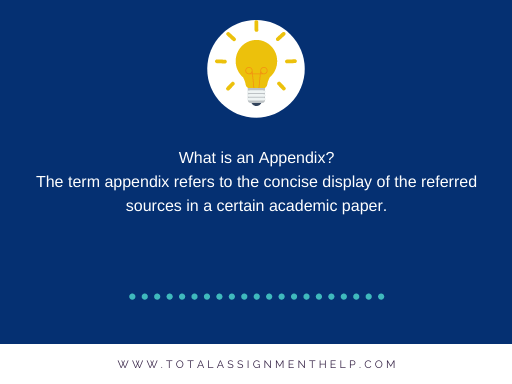
Actual significance and implication of an Appendix You may have the confusion that is it actually important to include the appendix section of your assignment and if yes what is the reason. Though the whole significance of the appendix is very large and discussing it is a very f=daunting task. It could be said in short that the set of complex information could be conveyed to the reader or the desired audience in a very systematic and effortless manner using an appropriate appendix format. This section would enlighten the targeted audience with further more information if they are interested to research further into the introduced topic.
Guidelines to be followed in drafting an appendix, Below is provided an authentic list and guidelines of different styles by which an efficient appendix could be drafted in our academic assignment papers. Different styles in the appendix have different modes of implication and hence could be studied with utmost cautiousness. By hearting different appendix style is the first step to be followed in learning its implication. Though the APA and MLA form of appendix seems to be very identical in their mode of implementation, they have evident differences in their mode of operation.
In the below section of this article on what is an appendix, is provided the checklist to be provided in the Appendix of an academic piece of literature.
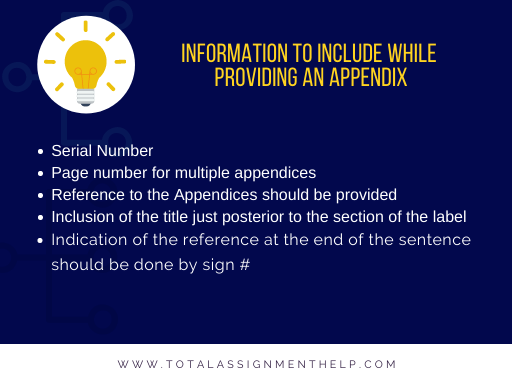
The page number should be provided for various references for multiple appendices.
The reference to the drafted appendices should be provided at the end of the relevant sentence.
Inclusion of the title just posterior to the section of the label. (This notion should be followed very strictly).
Indication of the reference at the end of the sentence should be done by sign #.
The initial paragraphs don’t come under this set of rules.
The use of double space should be used on the whole set of literature.
The middle paragraphs, i.e. the second and the third paragraph should be implying the above-said guidelines very strictly.
- The used set of sources should be provided with proper in-text citation of it prevails from the third party. Creating an elaborate reference list is much extravaganza and a waste of time.
- The reference serial number could also be included in the main body as the in-text citation.
Format of a general appendix It is quite evident that the format and guidelines to implement the appendix should be learned even before the application of the whole appendix in the desire academic piece of literature. Understanding or the mastering of the guidelines to be followed in the appendix could be done very easily. There should be no effort to byheart the format of appendix styles like MLA and APA. The whole dissertation would be very effective if the appendix is drafted in a very authentic way.
- Index Table – This table is being ensured by the appendices.
- Page Number.
- Reference List.
Drafting the section of Appendix in various format As mentioned earlier in this article, there are mainly two styles of the appendix in the academic stream. Most probably the tutors in the university provide the guidelines to draft the appendix either in MLA or APA style. Our vast panel of experts has devised out a very simplified methodology to master the rules to be followed in either of these two appendix styles. Please refer to the guidelines for both of the appendix style very cautiously, As mentioned earlier in this article, both of the appendix styles possess a lot of similarities among each other and hence there are some of the generic rules which would be implied in any of the appendix styles.
APA style of the appendix This style of appendix drafting is being recommended by a lot of professors in the university. The APA style appendix is very easy to draft in a paper and hence the guidelines should be drafted by the student as soon as possible.
- The plural of the appendix should be denoted as appendices.
- The whole appendices should be drafted as per the contextual chronology in which the sources are used.
- The list of appendices should be given heading
- The list of appendices should be placed after the list of references.
- The pages which consist of the list of appendices should be marked with appropriate page numbers and hence should be demarked properly in the table of contents.
- No matter what is the magnitude of the whole section of appendices, the whole consisting of pages should be marked with appropriate page numbers.
- The use of footnotes is a must in the case of APA style of the appendix.
These rules should be followed while preparing the assignment paper with APA style appendix. Exactly these are the parameters that are being checked by the evaluators in APA style appendix. The above provided general rules would help the student in drafting an APA style appendix in a very impeccable way. Make a note of the instructions we are providing in this article on what is an appendix.
- Imply the double-spacing throughout the content of the literature.
- Each item in the appendix should be provided with appropriate headings.
- All the paragraphs in the content should be formatted in the assigned design.
- The sources in the appendix should be pointed out separately.
- The pattern of indent should not be applied to the initial paragraph.
- You could use the sequence of ABC for the process of tilting in the multiple appendices.
- No matter whether the size of the appendices is small or humungous, it should be provided on a separate page.
- If the reference is to be included in the text itself include notation like (see appendix a) in middle.
- All the headings and the titles should be provided in the center alignment.
Chicago Style Appendix The Chicago style appendix is very much similar to the APA style of appendix drafting. Only there is some minor variation in between these styles of appendices. Below are provided some of the guidelines so that the Chicago style appendix could be implemented very effortlessly.
- If more than one reference is used in the appendix section, it should be denoted as appendices.
- The font of Times New Roman should be strictly used in the Chicago style of Appendix drafting.
- You could use footnotes in the section of bibliography and there are no strict restrictions regarding it.
- There should be an exclusive page for the bibliography sections. There should be no other content on the dedicated page of the bibliography.
- You should use the font size of 12 points in the overall body of the literature.
- All the pages should be numbered (Of course, the front page should not be numbered).
- The style of numbering the page should be like Page 1, Page 2, Page 3, etc.
- The number of the page should be displayed on the right side.
MLA Style Appendix The style MLA Appendix drafting is also quite similar to that of the drafting style used in that of APA form. The evident difference of the MLA appendix style from that of the APA appendix style is the presence of the appendix prior to the reference list.
- As mentioned in other styles, the section of the appendices should be provided on a separate page, irrespective of its volume.
- The separate section of appendices should be included prior to the reference list (quite different from other appendix styles).
- To apply the tilting process, the ABC should be used in the case of multiple appendices.
- The separate page number should be assigned to separate sections of the appendices.
- The sequence of the appendix should be done in the correct manner by which the resources are referred to in the whole body.
Please follow the below-given rules regarding the drafting process of MLA. If the rules are being understood very efficiently, then the implication of the whole appendix style would be very easy to do. Hence the student could evidently fulfill the requirement put forward by the professor.
- The titles of the referred sources should be displayed in the italic font. The referred ideology whether is quoted directly or the paraphrased version is used, then the proper in-text citation should be used at the proper place.
- The headings should be placed using central alignment.
- Whole content should be drafted by considering the double spacing.
- The name of the article, websites, books, journals, etc. should be represented in the font of italics.
- The references should be arranged in the left alignment. But there should be a hanging indent included in the reference list.
- The format of the reference should be in the order of Surname, First Name, Year of Publication.
- The whole list of references should be in alphabetical order. The first alphabet of the surname of the writer should be taken into account for this criterion.
Conclusion It could be easily concluded in this article on what is an appendix that mastering various styles of the appendix is a very easy task to do. The style of the appendix which are majorly used by the professors in colleges all over the world are APA, MLA, and Chicago style of the appendix and is very highly discussed in this article in what is an appendix. Just learning the APA style of the appendix would enable the student to easily learn the other two style of referencing very easily, since all of them are very similar to each other. Because of the high resemblance, the student first only needs to focus on a generic set of laws and in the case of each appendix style, he only needs to make small modifications. Focus on reciting the provided framework and guidelines in this article on what is an appendix. Only after reciting the general laws regarding the appendix, the student should move on with mastering various styles of the appendix. The overall study would enable the student in drafting his academic assignment in a very impeccable way, whether it is a research paper or an essay.
Still, finding it hard to understand what is an appendix? We understand that the drafting process of an appendix could be perceived by some of the students as a very complex and hard task. You could approach our assignment service for even the partial service of drafting the appendix. We have a vast team of experts, who are always ready to provide our students with academic assistance. If you are in need of academic assistance rush to our website to avail of our premium services at a very reasonable price. You are just one click away from the top-class assignment services. Let’s try it.
Thomas Smith
Related posts.
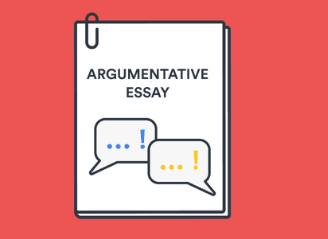
Refer To Argumentative Essay Examples To Write An Impeccable Argumentative Essay
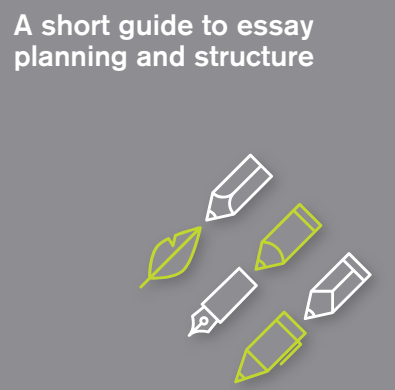
Write Essays By Using Essay Planning Tips And Techniques
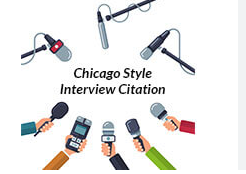
Learn How To Cite An Interview In Chicago Style With Examples
Leave a reply cancel reply.
Your email address will not be published. Required fields are marked *
Save my name, email, and website in this browser for the next time I comment.
- Writing Rules
- Running Head & Page numbers
- Using Quotations
- Citing Sources
- Reference List
- General Reference List Principles
- Structure of the Report
- Introduction
- References & Appendices
- Unpacking the Assignment Topic
- Planning and Structuring the Assignment
- Writing the Assignment
- Writing Concisely
- Developing Arguments
- Critically Evaluating Research
- Editing the Assignment
- Writing in the Third Person
- Directive Words
- Before You Submit
- Cover Sheet & Title Page
- Academic Integrity
- Marking Criteria
- Word Limit Rules
- Submitting Your Work
- Writing Effective E-mails
- Writing Concisely Exercise
- About Redbook
Appendices can be used in both lab reports and essays, and are used to provide the reader with specific information that would be distracting if it was placed in the body of your work. Appendixes should be placed after your reference list.
Common Types of Appendices
- Common types of appendices include (but are not limited to) the following:
- A sample of questionnaire items or other survey instruments used in the research;
- A figure or table of stimuli or other apparatus used during the research;
- Important information that you cannot fit within your essay due to the word count;
- Additional statistical tables or figures
Labelling Appendices
- If you only have one appendix in your paper, simply label it “Appendix”
- If you have two or more appendices, label each one with a capital letter (e.g., Appendix A, Appendix B etc.). Appendices MUST be labelled in the order in which they are mentioned in your paper.
- In your paper be sure to refer to each appendix by their labels, for example “…. as shown in Appendix A.”
APA Format for Appendices

Want to create or adapt books like this? Learn more about how Pressbooks supports open publishing practices.
APPENDICES: Academic Writing Basics
Technical Writing Essentials is designed to follow up on the skills learned in a first year Academic Writing course. If you’d like a refresher on some of the skills and ideas you learned in first year, an excellent open textbook used in some first year writing courses is Why Write? A Guide for Students in Canada . In particular, Chapter 5 of this textbook discusses grammar as a situated practice , offers an excellent overview of “ What is grammar ?” and provides some very helpful information on “ Rules for Academic Writing in English. ”
The following sections provide a review of some of the basic conventions and expectations of academic writing that students should be familiar with and that are relevant to technical writing:
Appendix A: Referring to Authors and Titles
Appendix B: Writing Summaries
Appendix C: Integrating Quotations, Paraphrases and Summaries into your Writing
Appendix D: Transitional Words and Phrases for University Writing
Appendix E: Sentence Structure
Appendix F: Punctuation Matters
Appendix G: Writing Comparisons
Appendix H: Peer Review Essentials
Technical Writing Essentials Copyright © by Suzan Last and UNH College of Professional Studies Online is licensed under a Creative Commons Attribution 4.0 International License , except where otherwise noted.
Share This Book
United States Department of Agriculture
Risk Management Agency
- Find an Agent
- Press Releases
USDA Expands Insurance Options for Specialty and Organic Growers
News release.
WASHINGTON, June 27, 2024 – The U.S. Department of Agriculture (USDA) is expanding crop insurance options for specialty and organic growers beginning with the 2025 crop year. USDA’s Risk Management Agency (RMA) is expanding coverage options by allowing enterprise units by organic farming practice, adding enterprise unit eligibility for several crops, and making additional policy updates. This is the first of several announcements this summer, which will include the expansion of the shellfish policy in the Northeast and new coverage for grape growers in the West and beyond. These expansions and other improvements build on other recent RMA efforts to better serve specialty crop producers and reach a broader group of producers.
“The Risk Management Agency is excited to expand coverage options for specialty and organic growers including the availability of enterprise and optional units for many producers,” said RMA Administrator Marcia Bunger. “Expanding our coverage options gives producers more opportunities to manage their risks. We will continue to build on our work through future announcements later this summer.”
The following changes will be made beginning with the 2025 crop year:
- Expand Enterprise Units (EU) to almonds, apples, avocado (California), citrus (Arizona, California, and Texas), figs, macadamia nuts, pears, prunes, and walnuts.
- Allow non-contiguous parcels of land that qualify for Optional Units (OU) to also qualify for EU.
- Allow EUs by organic farming practice for alfalfa seed, almonds, apples, avocado (California), cabbage, canola, citrus (Arizona, California and Texas), coarse grains, cotton, ELS cotton, dry beans, dry peas, figs, fresh market tomatoes, forage production, grass seed, macadamia nuts, millet, mint, mustard, pears, potatoes (northern, central, and southern), processing tomatoes, prunes, safflower, small grains, sunflower seed, and walnuts.
- Expand OUs by organic practice to all remaining crops where OUs are available, and the organic practice is insurable.
- Walnut Quality Adjustment: Allow sunburned damaged walnuts to be eligible for indemnity payments through quality adjustment.
- Almond Leaf Year: Expand insurance coverage to younger trees by including trees in their fifth leaf year after being set out.
- Processing Bean End of Insurance Period: Extend insurance coverage in Delaware, Maryland , and New Jersey by an additional 16 days.
- Canola: Expand insurance for canola into South Dakota and Michigan.
These revisions come through the Expanding Options for Specialty and Organic Growers Final Rule published today by the Federal Crop Insurance Corporation (FCIC). This Final Rule will update the Common Crop Insurance Policy Basic Provisions, Area Risk Protection Insurance Basic Provisions, and includes changes to individual Crop Provisions. The enterprise unit availability will continue to be rolled out throughout the year with each crop’s contract change date and RMA will continue to evaluate expanding EUs to additional crops.
Additional changes in the June 30 Final Rule include:
- Reduce administrative burdens on growers and the delivery system by removing written agreement requirements on new breaking acreage.
- Reduce coverage penalties on perennial specialty crop producers and producers of intensively managed crops, such as alfalfa, when they move to row crop production. This allows for a seamless transition without losing crop insurance coverage.
- Assignment of Indemnity: Provide flexibility for an indemnity payment to be issued via automated clearing house (ACH) or other electronic means when these methods do not allow for multiple payees.
- Good Farming Practices (GFP): Streamline and shorten the FCIC GFP reconsideration process by closing the administrative file following FCIC’s initial GFP determination.
- Double Cropping and Annual Forage: Clarify a producer must prove insurance history for the annual forage crop and meet the current double cropping requirements to receive a full prevented planting payment.
RMA continues to explore ways to improve risk management tools for specialty crop producers and will be announcing additional program enhancements later this summer. Some of those improvements include:
- Expanding the Shellfish Program to an additional 18 counties in seven states. Additional modifications include allowing insurance on seeds initially purchased smaller than 4 mm, allowing producers to use existing records for coverage in adjacent program counties, and allowing alternative yield procedures.
- Piloting the Fire Insurance Protection – Smoke Index (FIP-SI) crop insurance program for grapes in California for the 2025 crop year. The pilot program is an index-based endorsement to the Actual Production History (APH) Grape policy that provides additional protection against smoke damage and covers the liability between the APH policy’s coverage level and 95%.
- Expanding the Enhanced Coverage Option (ECO) to walnuts and citrus crops and increasing premium support to be consistent with the Supplemental Coverage Option.
- Expanding the Grapevine insurance program to an additional 29 counties in California. Grapevine insurance offers protection against vine losses in the event of several named perils.
- Releasing new Organic Practice Guidelines to producers for the 2025 crop year. These guidelines are to help producers report planted or perennial acreage insured under a certified organic or transitional practice.
More Information
This announcement further advances USDA’s recently announced Specialty Crops Competitiveness Initiative, a Department-wide effort to increase the competitiveness of specialty crops products in foreign markets, enhance domestic marketing, and improve production and processing practices.
Crop insurance is sold and delivered solely through private crop insurance agents. A list of crop insurance agents is available at all USDA Service Centers and online at the RMA Agent Locator . Learn more about crop insurance and the modern farm safety net at rma.usda.gov or by contacting your RMA Regional Office .
USDA touches the lives of all Americans each day in so many positive ways. Under the Biden-Harris administration, USDA is transforming America’s food system with a greater focus on more resilient local and regional food production, fairer markets for all producers, ensuring access to safe, healthy and nutritious food in all communities, building new markets and streams of income for farmers and producers using climate smart food and forestry practices, making historic investments in infrastructure and clean energy capabilities in rural America, and committing to equity across the Department by removing systemic barriers and building a workforce more representative of America. To learn more, visit usda.gov .
USDA is an equal opportunity provider, employer and lender.

IMAGES
VIDEO
COMMENTS
Appendix format example. The appendix label appears at the top of the page, bold and centered. On the next line, include a descriptive title, also bold and centered. The text is presented in general APA format: left-aligned, double-spaced, and with page numbers in the top right corner. Start a new page for each new appendix.
An appendix (plural: appendices) is a section at the end of a book or essay containing details that aren't essential to your work, but which could provide useful context or background material. In the main body of your essay, you should indicate when you're referring to an appendix by citing it in parentheses.
Essentially, an appendix is a compilation of the references cited in an academic paper, prevalent in academic journals, which can be found in any academic publication, including books. Professors frequently require their students to include an appendix in their work. Incorporating an appendix in your written piece can aid readers in ...
3. Put your appendices either before or after your references page. It's most common to put the appendices after your references since they're an add-on to your paper. However, you can choose to put the references last if that's how you want your paper to appear. Do what works best for your paper.
Research Paper Appendix | Example & Templates. Published on August 4, 2022 by Tegan George and Kirsten Dingemanse. Revised on July 18, 2023. An appendix is a supplementary document that facilitates your reader's understanding of your research but is not essential to your core argument. Appendices are a useful tool for providing additional information or clarification in a research paper ...
4. Add page numbers. You should make sure the appendix has page numbers at the bottom right corner or the center of the page. Use the same page number formatting for the appendix that you used for the rest of the paper. Continue the numbering from the text into the appendix so it feels like part of the whole.
Put the appendix label centered at the top of the page. On the next line under the appendix label, place the centered title of the appendix. If you refer to a source in your appendix, include an in-text citation just as you would in the main body of your paper and then include the source in your main reference section.
Each appendix must be labeled with a letter (A, B, C, etc.) according to where it appears in the paper. The first appendix referred to in the paper would be named Appendix A. The second appendix referred to in the paper would be named Appendix B. If you have more than 26 appendices, start the alphabet over with AA, BB, CC, and so on.
Use a separate appendix for each type of information; Clearly label each appendix with a letter or number, plus a title that tells the reader what it contains (e.g., Appendix A: Survey Results) Include all appendices in the table of contents at the start of your document; If you do all of this, you should have a good set of appendices on your ...
Tables, Images, & Appendices. For some papers and reports, you may choose to add a table, graph, chart, or image within the body of the draft. Or you may choose to include an appendix at the end of your paper. These can help to provide a visual representation of data or other information that you wish to relay to your reader.
Appendices should be included at the end of the assignment, and you must include them at the end of your reference list. and every appendix must be aligned with the citation, table, or figures that are included after the paper. additionally, if you have an excessive number of appendices, be sure to include them separately.
The heading should be "Appendix," followed by a letter or number [e.g., "Appendix A" or "Appendix 1"], centered and written in bold type. If there is a table of contents, the appendices must be listed. Depending on the type of information, the content can be presented in landscape format rather than regular portrait format.
Appendices. An appendix** comes at the end (after the reference list) of a report, research project, or dissertation and contains any additional information such as raw data or interview transcripts. The information in the appendices is relevant but is too long or too detailed to include in the main body of your work. **Note: Appendix is ...
How to format an appendix. The heading should be APPENDIX or Appendix, followed by a letter or number: e.g. APPENDIX A, Appendix 1, centred, bold. Each appendix must begin on a new page. Appendices must be listed in the table of contents (if used). The page number (s) of the appendix / appendices will follow on from the body of the text.
How to write an appendix. Here are six steps you can follow when writing and formatting your appendix: 1. Organize information into similar parts. To create an appendix that is easy to read and navigate, organize similar information together so readers can quickly scan each section to review data and resources.
Label the appendices: Label each appendix with a capital letter (e.g., "Appendix A," "Appendix B," etc.) and provide a brief descriptive title that summarizes the content. F ormat the appendices: Follow the same formatting style as the rest of your paper or report. Use the same font, margins, and spacing to maintain consistency.
Sometimes an appendix may be used for ESSENTIAL tables and figures which are too large to fit into the text of an essay/report. The conventions for appendices are as follows: each appendix must be labelled with a number (or letter) and title e.g. Appendix A : Cross Sectional Data Set; there should be a page break between Appendix A, B etc.
The section of the appendix would help a person in grasping the idea of what data have been used in drafting the same academic assignment. Since it is a necessary part of an academic paper, certain rules should be followed in drafting an appendix in the paper. The style of drafting the appendix would depend on the guidelines provided by the ...
Student 2 (reflective writing) In my nursing assignment, appendices were used to supplement the information in my essay. Firstly, we had to demonstrate our knowledge of the human skeletal system. The photocopied diagrams covered a number of pages, so Appendix A was a set of photocopied, labelled diagrams of the skeletal system
Appendices. Appendices can be used in both lab reports and essays, and are used to provide the reader with specific information that would be distracting if it was placed in the body of your work. Appendixes should be placed after your reference list.
The following sections provide a review of some of the basic conventions and expectations of academic writing that students should be familiar with and that are relevant to technical writing: Appendix A: Referring to Authors and Titles. Appendix B: Writing Summaries. Appendix C: Integrating Quotations, Paraphrases and Summaries into your Writing.
WASHINGTON, June 27, 2024 - The U.S. Department of Agriculture (USDA) is expanding crop insurance options for specialty and organic growers beginning with the 2025 crop year. USDA's Risk Management Agency (RMA) is expanding coverage options by allowing enterprise units by organic farming practice, adding enterprise unit eligibility for several crops, and making additional policy updates.
Essay Help - Using an Appendix - The appendix may be used for helpful, supporting or essential material.